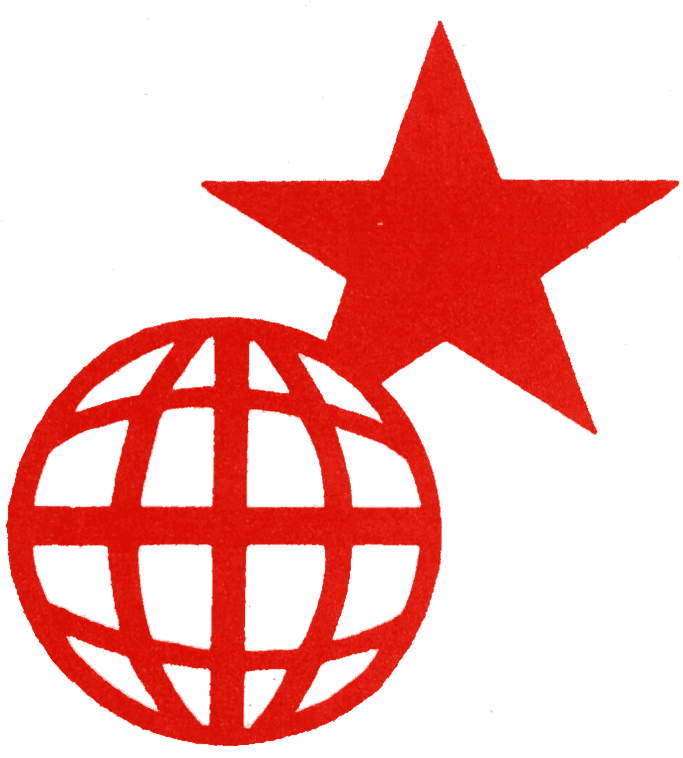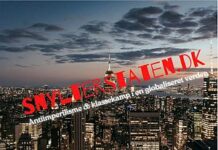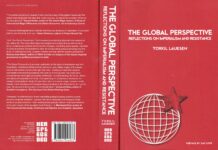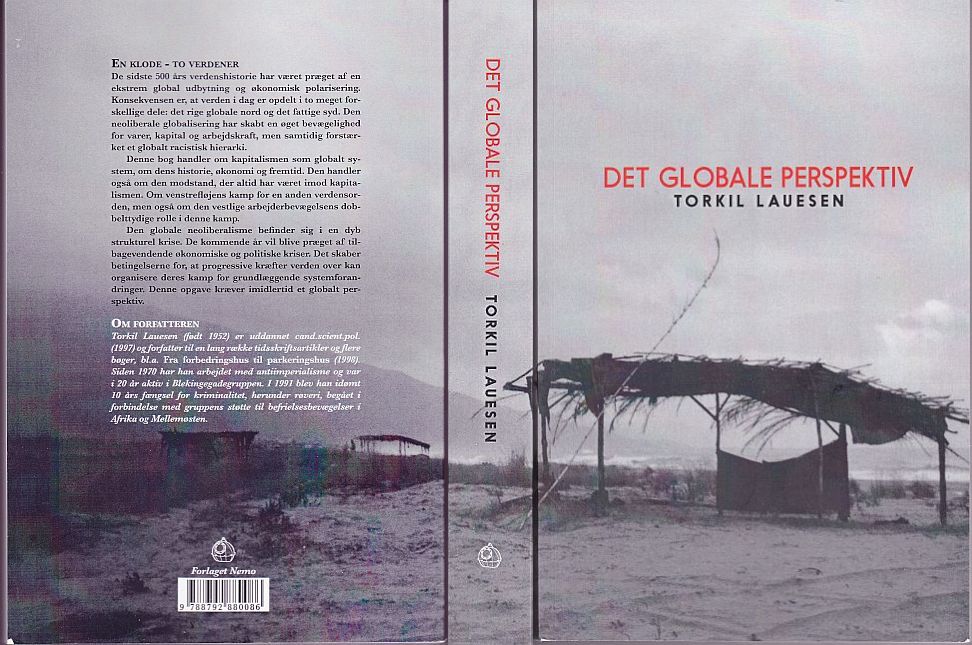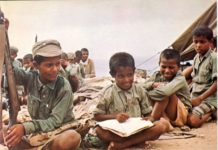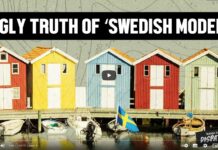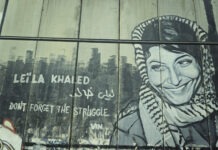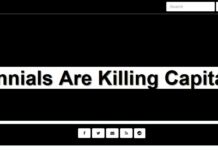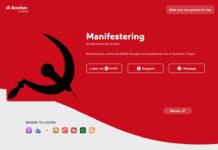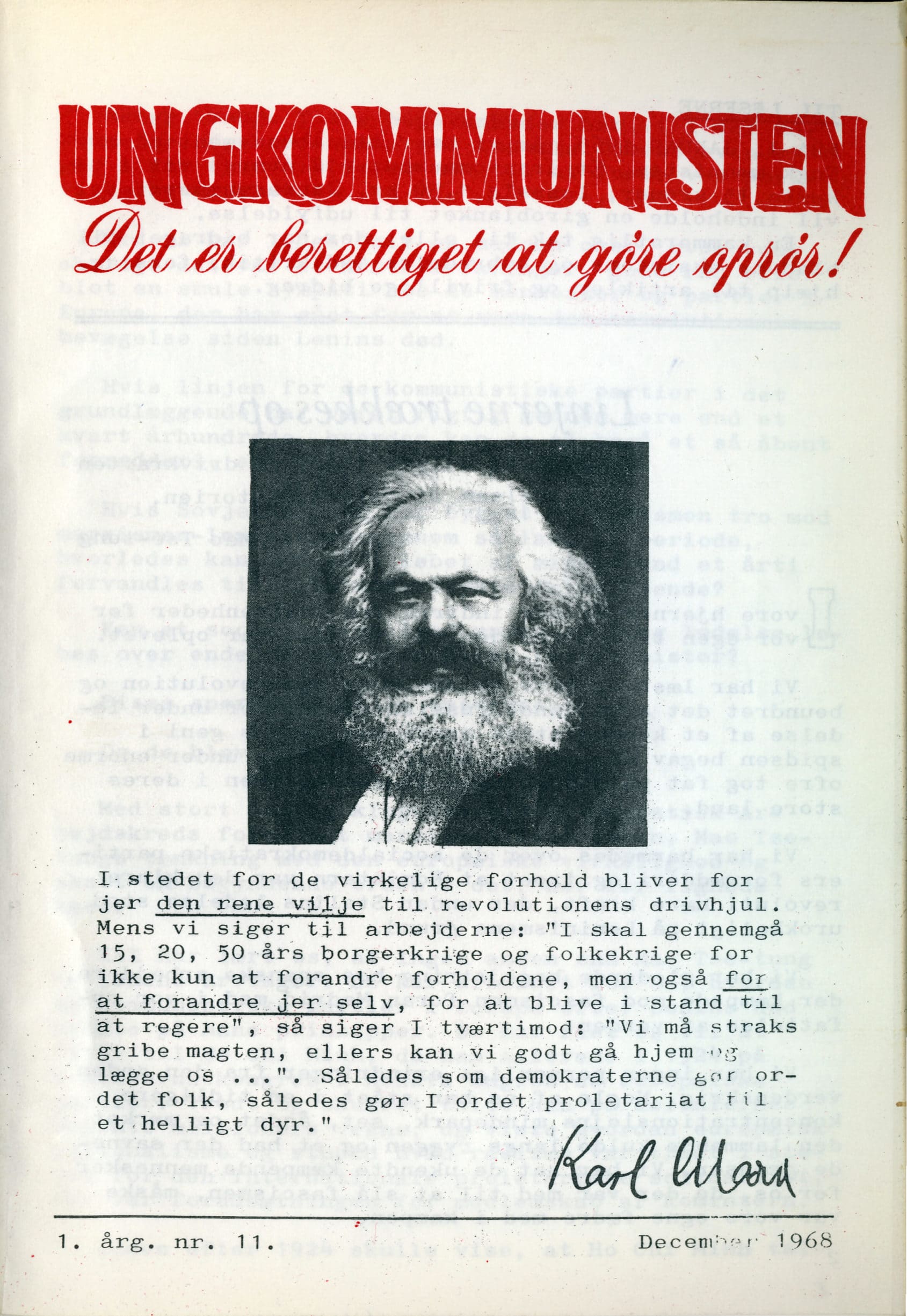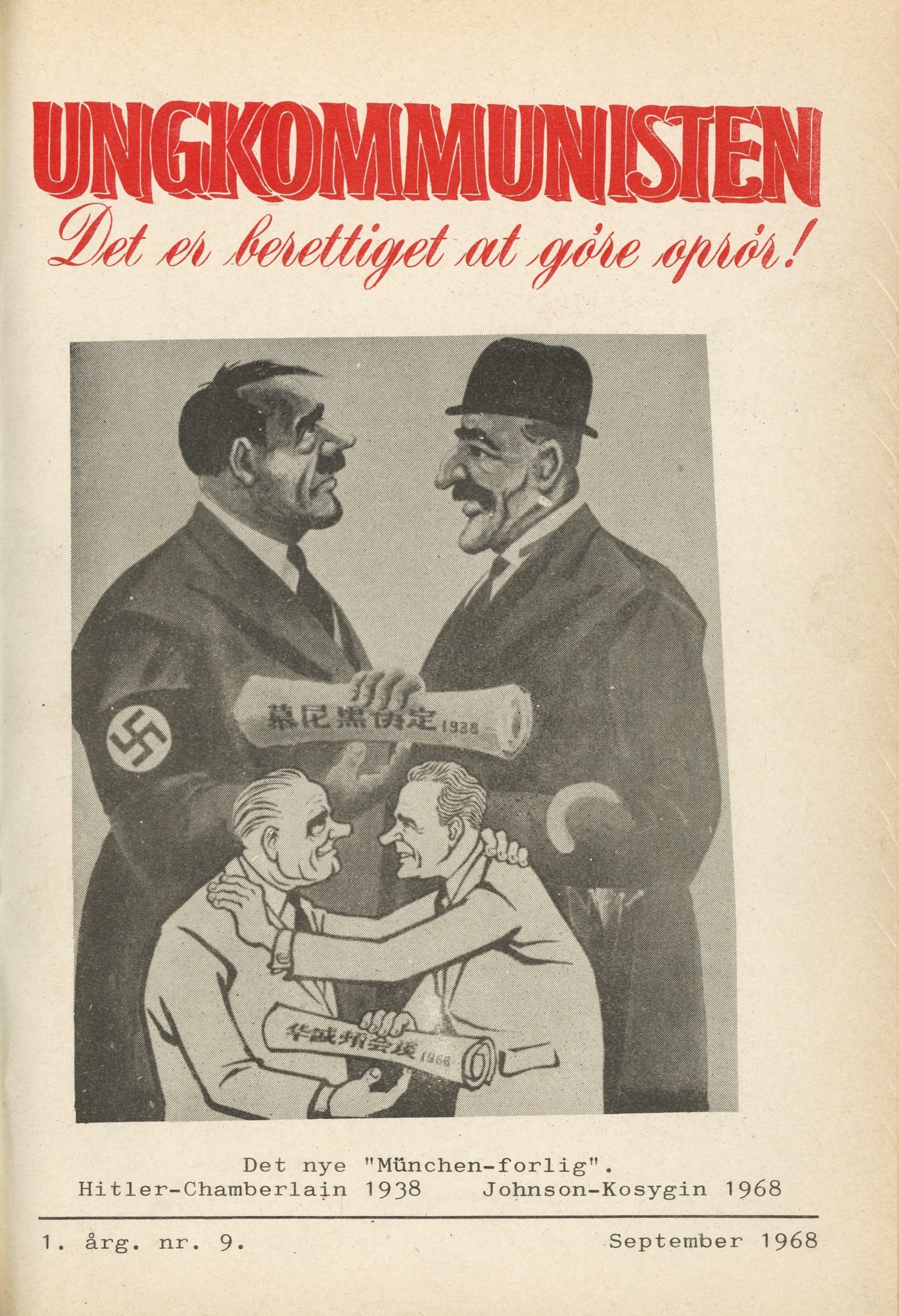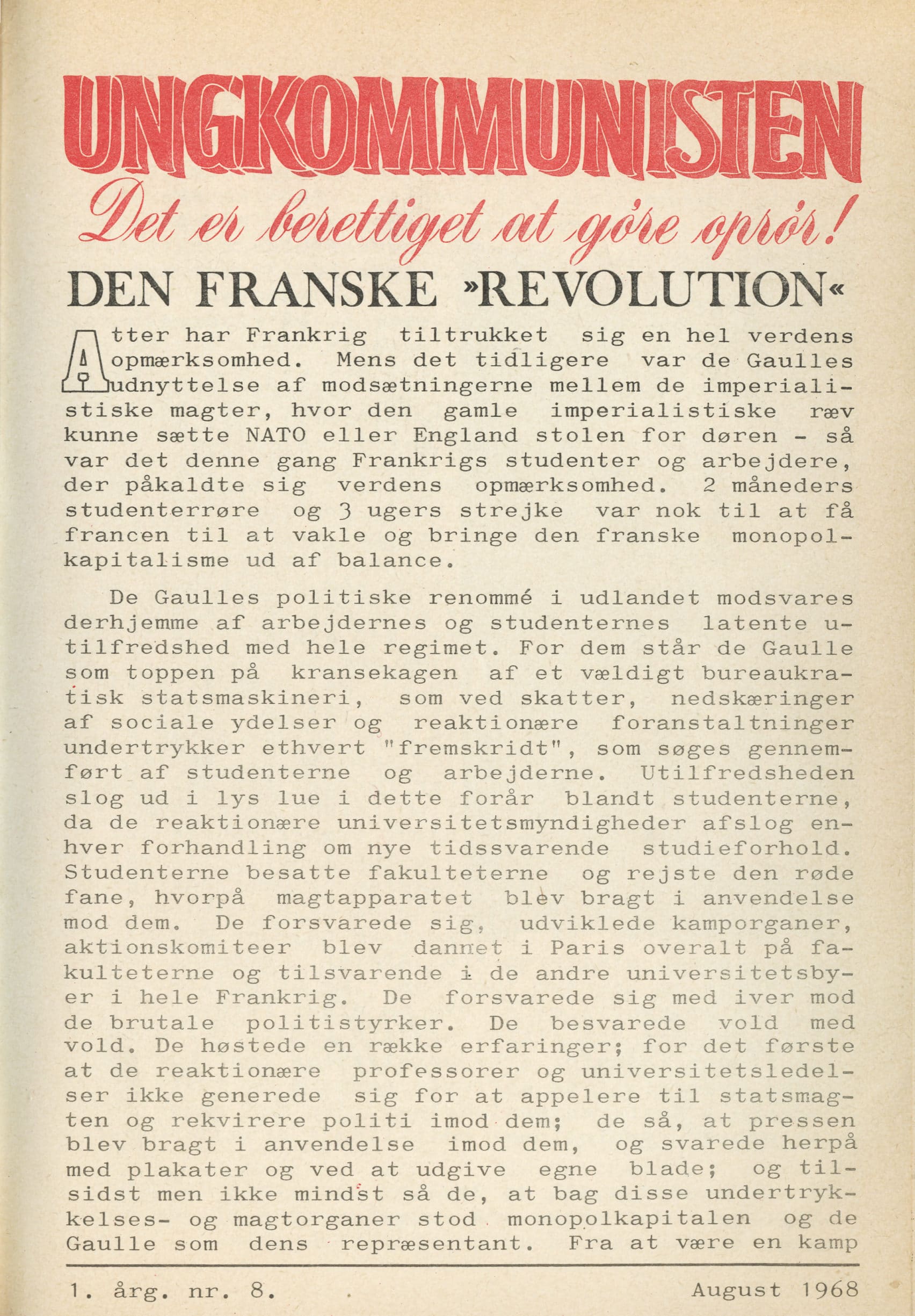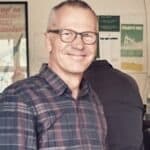The first section of the article addresses four topics:
- KAK’s origins and the development of its political theory, that is, the “parasite state theory.”
- KAK’s legal and illegal practice.
- Our relationship to the PFLP and our reasons for not having any connections to the German Red Army Faction, RAF, and Wadi Haddad’s Special Operations. [3]
- The split within KAK and the founding of M – KA.
KAK and Our Political Origins
In order to understand the background of our political practice it is necessary to describe KAK, the organization in which we received our political schooling.
This description entails:
- a short overview of KAK’s history and theory, with a particular focus on the international political framework in which the organization was formed
- the organizational characteristics of KAK, which had two objectives: one, to form an effective political group, and two, to make a small contribution to undermining imperialism by supporting strategi-cally selected liberation movements
- a rejection of the claim that KAK was a Maoist organization through-out the 1970s
- a rejection of our portrayal as politically isolated dreamers, when our political worldview was shared by many movements and theorists who we were in constant contact with
- an explanation for why KAK chose an illegal political practice in addition to a legal one
KAK was founded in 1964 by former members of the Danish Communist Party, DKP. The early KAK leadership consisted of seven people, including Gotfred Appel and Benito Scocozza. [4] KAK’s journal was named Kommunistisk Orientering. After its foundation, KAK published a twelve-point program, in which it criticized the DKP and the Soviet Union. [5] KAK’s members were strongly inspired by Mao and the Communist Party of China, CPC.
In addition to the Maoist orientation, KAK had a strong internationalist outlook and was the first organization in Denmark to call for a demonstration against the Vietnam War. The demonstration was held on February 8, 1965, under the slogan, “Free the South, Defend the North, Reunite the Fatherland!” The same year, KAK took the initiative to collect money for a leprosy sanatorium in North Vietnam. This lay the foundation for the support of liberation movements that later became the organization’s focus. KAK thought that the fight against American imperialism would undermine the capitalist system and bring us closer to socialism. In 1966, KAK founded the Vietnam Committee (Vietnamkomité), which turned into a broad social movement.
Soon, however, KAK experienced internal conflict. Members were divided in their evaluation of the Danish working class’s revolutionary potential. As a result, Benito Scocozza and others left. This made KAK a more united and focused organization, but also a smaller one. The remaining members were convinced that the fight for Vietnam’s liberation was the most important struggle for socialists, even in Denmark.
KAK published an increasing number of articles explaining the difficulties in mobilizing Danish workers for international solidarity. Its analysis was that the Danish working class had been “bribed” with high wages. In 1966, the essence of what was later called the “parasite state theory” was outlined in a Kommunistisk Orientering article. The article emphasized the consequences of the theory for socialists in the rich countries: “If we want socialism to become a reality in the Western capitalist world, including Denmark, then it is our highest duty to support oppressed nations and peoples in their fight against Western capitalism, the common enemy.” [6]
In 1968, KAK founded the youth organization Kommunistisk Ungdomsforbund, KUF, which published the journal Ungkommunisten. KAK was still small and wanted to attract young activists. One of KUF’s first initiatives was the founding of the Anti-imperialist Action Committee (Anti-imperialistisk Aktionskomité).
Only at this point did we personally enter the picture. None of us was part of KAK’s early history. Jan Weimann first established ties to KAK in 1967 during a demonstration against the Greek military junta. Niels Jørgensen joined the organization in 1969 after meeting KUF members during protests against the Copenhagen screening of The Green Berets, a film glorifying U.S. war crimes in Vietnam. Torkil Lauesen joined KUF in 1971. Holger Jensen, who received much attention in PØK’s book, became the leader of the Antiimperialist Action Committee.
By 1968, KAK was led by Gotfred Appel and his partner Ulla Hauton. The parasite state theory became increasingly important for the organization. [7] Its essence was that the rich (imperialist) countries exploited the countries of the Third World, mainly in the form of “superprofits” extracted as a result of foreign direct investments. The superprofits not only made Western capitalists richer but also increased the wages of the Western working class, which now no longer had “only its chains to lose.” [8] Western workers now also had an objective interest in defending global capitalism, since the system guaranteed them disproportionately high wages. It was crystal-clear to us that the Western European working class was not revolutionary in the 1960s – you just had to take a good look around you. This realization became our starting point. It defined, in a nutshell, the parasite state theory.
When Appel and Hauton added the final touches to the parasite state theory in 1968, KAK was still the official Danish ally of the CPC and owned the exclusive rights to the Danish edition of Mao’s Little Red Book.
From Maoism to Anti-imperialism
When the CPC held its Ninth National Congress in 1969, some of its declarations sounded as if the revolution in Western Europe would break out any minute. Its description of the Western European working class as “revolutionary” was a complete delusion. KAK criticized this in a special issue of Kommunistisk Orientering. As a result, the official ties to the CPC were cut.
A look at the texts published in Kommunistisk Orientering during the 1970s makes it clear that KAK was no longer a Maoist organization. The issues from 1974 and 1975 [9] include a description of KAK’s politics, a critique of Scocozza, a critique of the German RAF, a contribution by Don Barnett, [10] and articles on socialist theory, the famine in India, multinational oil companies, the West German working class, and U.S. agricultural policies. Not a single article talks about China. The fact that KAK was hoping for China to build a socialist state without repeating the mistakes of the Soviet Union under Stalin does not mean that KAK was Maoist. It is therefore incorrect when PØK and others speak of KAK as a Maoist organization during that time. The members of KFML/KAP, led by Benito Scocozza, took on the role of being China’s supporters in Denmark. PØK belonged to the organization for some time, so he should know this.
Let us summarize:
- KAK’s political line differed in many ways from that of the CPC.
- We had a completely different analysis of the Western working class.struggle was the one of the Western working class.
- We had completely different perspectives on the Soviet Union: while we saw the Soviet Union as a tactical ally in the fight against imperialism (even if we didn’t see eye to eye with them on everything, especially not the political implementation of socialism), the CPC saw the Soviet Union as the most dangerous imperialist power of them all. [11]
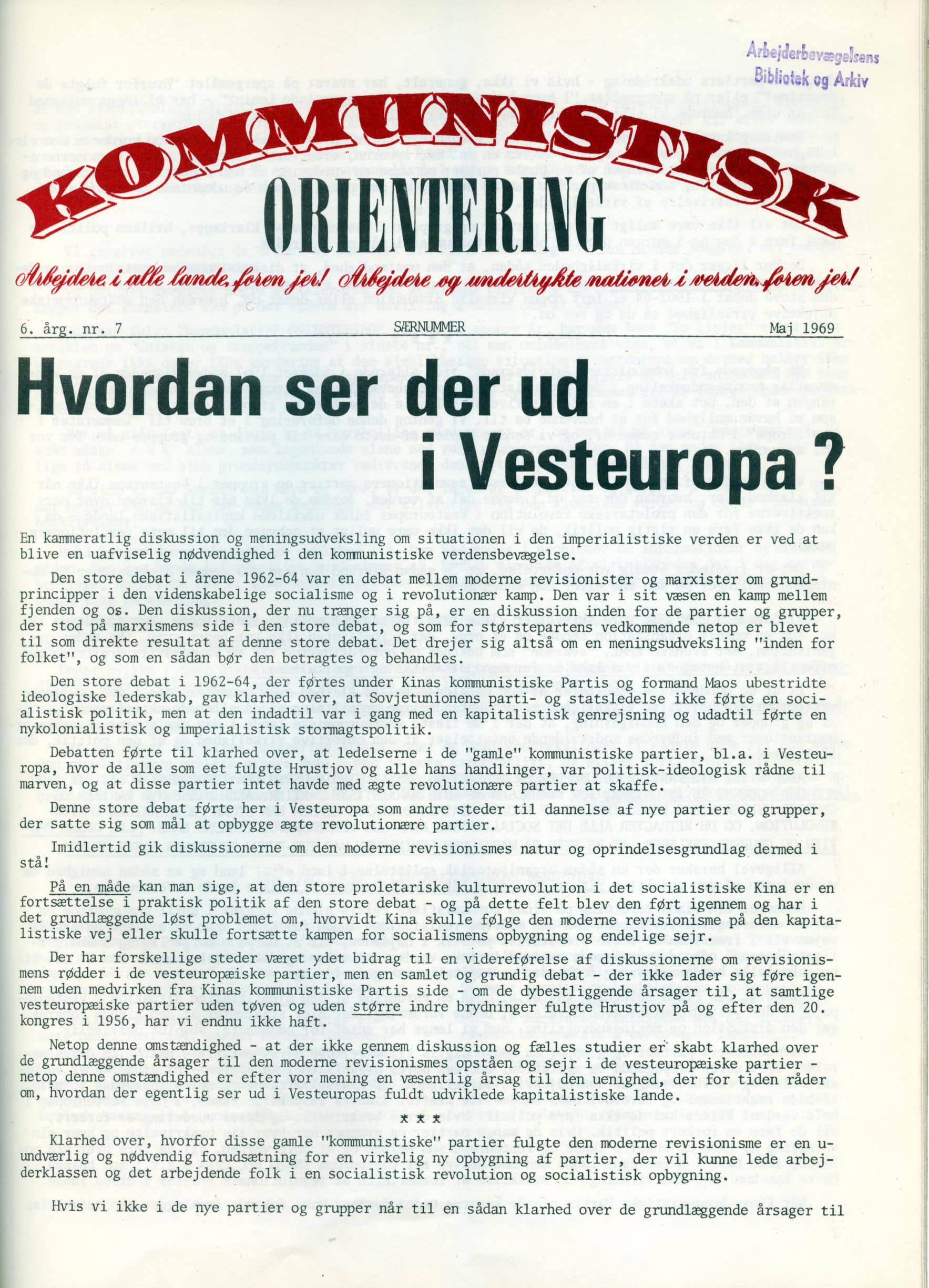
Basically all of the Third World movements we supported were criticized by the CPC and the Maoist organizations in Western Europe. Most Maoist organizations supported other movements; movements we had no sympathies for whatsoever. In Angola, for example, we supported the MPLA, while China supported UNITA and FNLA. UNITA was a group of anticommunist bandits who terrorized the civil population. By supporting them, China formed an alliance with the U.S., South Africa, and Israel. Later they also collaborated with the FNLA, which was known for murdering everyone when attacking white farms: the white owners as well as the black workers and their families. In the Middle East, the Chinese approach was also different from ours. The PFLP never received any support from China other than a box full of Mao books.
For younger generations, the differences between the socialist organizations of the 1970s might amount to little more than choosing different chiefs. For those of us who were active at the time, however, these differences were crucial. It was important that we were not Maoists, because we fundamentally disagreed with China’s foreign policy. Our reference points were the unjustified exploitation and oppression of the Third World and the sympathies we had for the revolutionary movements emerging there as a consequence of this.
In our analysis, the Marxist concept of “contradiction” played a central role. In short, a contradiction consists of two forces opposing one another and being dependent on one another at the same time. Traditional Marxist literature focuses on the contradiction between capitalists and workers. For us, the main contradiction was the one between the poor/exploited countries and the rich/imperialist ones. On the basis of the parasite state theory, we saw the contradiction between workers and capitalists in the Western world mitigated; they shared a common short-term interest, namely the increase of profits made from Third World exploitation (even if there was a constant struggle over the profits’ distribution, mainly expressed in wage disputes).
For us, the Third World was the focal point. It was in the Third World where social mass movements emerged and political organizations took up arms to overthrow the local elites and to end imperialist exploitation. We saw it as our main task to support these movements and organizations in their struggle.
Unity with Third World Liberation Movements
We were not alone in our analysis, even if it was not especially popular among the Danish left. The Third World liberation movements we collaborated with shared our views. We had the same goals: to liberate the Third World from imperialism; to end economic exploitation; and to move in a socialist direction. Che Guevara, one of the leaders during the Cuban Revolution, and later Cuba’s foreign minister, famously spoke of creating “many Vietnams”:
How close and bright would the future appear if two, three, many Vietnams flowered on the face of the globe, with their quota of death and their immense tragedies, with their daily heroism, with their repeated blows against imperialism, forcing it to disperse its forces under the lash of the growing hatred of the peoples of the world! [12]
Our support for Third World liberation movements had both a short-term and a long-term goal. The short-term goal was to help establish Third World countries’ economic and political self-determination. The long-term goal was to diminish the superprofits of the imperialist countries’ capitalists and to thereby give new urgency to the contradiction between these countries’ capitalist and working classes. As a consequence, socialism would become a possibility even in our part of the world. Many Third World leaders and revolutionaries shared this perspective. Jawaharlal Nehru, India’s first prime minister, wrote the following already in 1933:
It is said that capitalism managed to prolong its life to our day because of a factor which perhaps Marx did not fully consider. This was the exploitation of colonial empires by the industrial countries of the West. This gave fresh life and prosperity to it, at the expense, of course, of the poor countries so exploited. [13]
Che Guevara wrote in 1965:
Ever since monopoly capital took over the world, it has kept the greater part of humanity in poverty, dividing all the profits among the group of the most powerful countries. The standard of living in those countries is based on the extreme poverty in our countries. To raise the living standards of the underdeveloped nations, therefore, we must fight against imperialism. [14]
Julius K. Nyerere, at the time the president of Tanzania, compared the conditions of the nineteenth-century European working class with the labor force of the poor nations in 1973:
The only difference between the two situations is that the beneficiaries in the international situation now are the national economies of the rich nations ― which includes the working class of those nations. And the disagreements about division of the spoils, which used to exist between members of the capitalist class in the nineteenth century, are now represented by disagreement about the division of the spoils between workers and capitalists in the rich economies. [15]
Not only politicians shared our analysis. Also numerous scholars did. Eric Hobsbawm, one of the world’s most renowned historians, wrote about the connection between imperialism and the labor aristocracy in 1964:
The roots of British reformism no doubt lie in the history of a century of economic world supremacy, and the creation of a labour aristocracy, or even more generally, of an entire working class which drew advantages from it. [16]
In 1970, the respected economist Joan Robinson stated the following:
It was not only superior productivity that caused capitalist wealth to grow. The whole world was ransacked for resources. The dominions overseas that European nations had been acquiring and fighting over since the sixteenth century, and others also, were now greatly developed to supply raw materials to industry. … The industrial workers at home gained from imperialism in three ways. First of all, raw materials and foodstuffs were cheap relatively to manufactures which maintained the purchasing power of their wages. Tea, for instance, from being a middle-class luxury became an indispensable necessity for the English poor. Secondly the great fortunes made in industry, commerce and finance spilled over to the rest of the community in taxes and benefactions while continuing investment kept the demand for labour rising with the population. … Finally, lording it around the world as members of the master nations, they could feed their self-esteem upon notions of racial superiority. … Thus the industrial working class, while apparently struggling against the system, was in fact absorbed in it. [17]
The Political Situation in the 1970s
While the revolutionary perspectives in Western Europe seemed to decline, the situation in the Third World looked promising, as the rebellion against imperialism and colonialism was on the rise everywhere. There were many possible reasons for a liberation struggle emerging in a particular place. The wish for national independence – the national aspect – was one. The wish for food on the table and for breaking the power of a foreign ruling class as well as the exploitation of resources and labor by foreign corporations – the economic aspect – was another. The wish for fundamental changes to power relations and the distribution of resources within the country – the socialist aspect – was a third. Often, two or all three of them were interrelated.
The national aspect
The national movements wanted to end the political domination of foreign powers. Their objective was decolonization. On the African continent, Algeria achieved liberation from France in 1962. There was a national liberation struggle in Eritrea. There were uprisings in the Portuguese colonies of Mozambique, Angola, Guinea-Bissau, and the Cape Verde Islands. The national aspect was also strong in countries where the political power was in the hands of a white minority. In Rhodesia (today’s Zimbabwe), a national liberation struggle was waged against Ian Smith’s settler regime. There was a liberation struggle in South-West Africa (today’s Namibia), and the struggle against the apartheid regime in South Africa. In the Middle East, the Palestinian liberation movement grew rapidly, and in Turkey, the Kurdish minority rose up in protest.
The economic aspect
There were uprisings in many of the countries in which people experienced particularly severe forms of exploitation and oppression. People who had nothing to lose (workers, peasants, slum dwellers, etc.) fought against feudal and capitalist regimes that were often dependent on foreign powers. There was revolutionary unrest in Morocco. In Ethiopia, Emperor Haile Selassie was ousted in a coup in 1974. In Iran, people rebelled against the Shah. Latin America experienced a wave of rebellions and social change. Fidel Castro seized power in Cuba in 1959. Salvador Allende was elected head of state in a democratic election in Chile in 1970. Strong liberation movements were active in Guatemala, Nicaragua, and El Salvador. Latin America was known as the backyard of the CIA, which supported the most corrupt and brutal regimes. In many countries, death squads tortured and killed dissidents, whether they were oppositional politicians, unionists, or revolutionary Catholic priests.
The socialist aspect
Numerous liberation movements had a socialist ideology similar to KAK’s. The socialist perspective of the Vietnamese revolution affected liberation movements in other Asian countries, especially in Cambodia and Laos, while new communist movements were emerging in Thailand and in the Philippines. In South Yemen, a left-wing leadership had seized power, while a liberation movement was gaining strength in Oman.
The struggle was global and the prospects were bright
Undoubtedly, the Vietnamese Front National de Liberté, FNL, was responsible for much of the optimism with which we, and others, approached Third World liberation struggles. The FNL had been founded in South Vietnam in 1960 and, with the support of the North, it had been fighting for fifteen years for a free and united Vietnam. The struggle was directed against the ruling South Vietnamese elite and its foreign allies, first France and then the U.S. The goal was to create a united socialist nation. This became a reality after Saigon was conquered on April 30, 1975. The FNL knew – and proved – that it was possible to stand up against any force, even if it was as powerful as the U.S. Army.
Several new nations with socialist promise were established as a result of successful liberation struggles at the time. In the mid-1970s, you could cover the entire world map with red pins if you used one for every active liberation movement. The struggle in the Third World was real. It was no fantasy. [18]
The role of the USA
The uprisings were centered in the Third World, but rebellious movements were also emerging in the U.S. The black struggle for equal rights made headlines around the world every day. Demonstrations against government policies gathered thousands of people. Some political groups seemed to prepare for open struggle; we are thinking particularly of the Black Muslims and the Black Panther Party for Self-Defense.
The Black Panthers were founded in 1966 by Huey P. Newton, Bobby Seale, and others. One of their objectives was to protect the black community from police brutality. Therefore they armed themselves for self-defense, which, as we know, is legal in the U.S. In 1968, their newspaper had a print-run of five hundred thousand. Very soon, the organization was brutally and systematically crushed by the American state. The police attacked one Panther office after another and killed many of the movement’s members, including some of its most prominent leaders. As a result, many Panthers were forced to go underground or flee the country.
In 1969, there also appeared a militant group of white socialists, the Weather Underground, who, in opposition to the war in Vietnam, committed acts of sabotage against government offices and the American weapons industry.
None of this meant that a revolution in the U.S. was waiting around the corner. But it showed that even the U.S. was fragile. It seemed that if the flow of wealth from the poor countries to the U.S. could be stopped, the country would experience a crisis that would not be solved by a few simple reforms.
In short, in the late 1960s and the early 1970s, there was a real possibility – a “window” – for radical global change. We saw the combination of anti-colonial and anti-imperialist struggles in many parts of the Third World and the anti-authoritarian youth revolt in Europe as the objective conditions for such a change to not only be possible, but probable. This contributed to our radicalization and commitment as militants. We were not just pursuing a dream. It seemed possible for us to be a small wheel in a big revolutionary process.
Political studies
The study of Marxism, that is, the study of historical materialism and political economy, was very important for us. It made us understand how the world’s forces related to one another. It was important for us that our practice be based on theory as well as empirical analysis, and not just on wishful thinking. We wanted to understand the patterns of economic exchange and the fabric of social relations. We considered this mandatory for being able to effectively change the world. A lot of time went into studying Karl Marx’s Capital. We also conducted economic analysis as well as in-depth political studies of various countries, and examined the liberation movements we considered collaborating with. In all of this, a purely theoretical perspective was never enough. KAK members embarked on many travels in the early 1970s to get a better understanding of what life was like in different parts of the world. Each journey lasted up to a few months. The experiences were summarized in reports about economic conditions, power relations, living standards, imperialist dependencies, etc. The reports were then discussed at KAK meetings. The countries we visited were India, Iraq, Iran, Syria, Israel, Lebanon, Egypt, Tanzania, Kenya, and the Western countries of Portugal, Germany, Northern Ireland, the USA, and Canada.
Our studies seemed to confirm that the revolutionary potential lay in the Third World where capitalism produced the value it needed to retain its momentum and where objective reasons (exploitation and oppression) existed for radical resistance to emerge.
The Western European working class desired higher wages and stronger welfare. It did not desire radical change. This implies no moral judgment. It was a simple matter of interests. Our analysis corresponded to our own experiences. In the late 1960s and early 1970s, many KAK members worked at big companies: B&W, FLSmidth, Tuborg, and others. [19] In the mid-1970s, four KAK members also worked in Germany for a year to get an impression of the situation in a different Western European country.
Today, we believe that history has proven our analysis right. Since the 1970s, the Western European working class has not shown any desire for revolutionary change. We were not the dreamers; we were the realists. It wasn’t us but the DKP and KAP who wrote socialist programs for Denmark.
In Marxism, one distinguishes between a revolution’s object and subject. The object is the economic and political conditions you wish to change. The subject is the oppressed and exploited social groups that can make this change possible. In traditional Marxist theory, it is the working class that occupies the role of the revolutionary subject. However, we did not see the Western working class as such, since its situation was not defined by exploitation and oppression, at least not primarily. On the contrary, Western European workers had much to lose: their living standards were high; many working-class families owned a house and a car. There was no desire for revolution. The situation was entirely different for workers and peasants in Third World countries. It is wrong to say that we substituted ourselves – or a small group of militants – for the working class. The people we saw as the revolutionary subject were the ones active in Third World movements with popular support.
If a revolutionary movement wants to be successful it needs a population that is both tired of the old political system and disillusioned with democratic solutions. Marx spoke of a class that had nothing to lose “but its chains”:
The Communists disdain to conceal their views and aims. They openly declare that their ends can be attained only by the forcible overthrow of all existing social conditions. Let the ruling classes tremble at a Communistic revolution. The proletarians have nothing to lose but their chains. They have a world to win. Working men of all countries, unite! [20]
We found meaning in our political work, because we saw a correlation between our theoretical studies and our practical experiences. Our political commitment was based on the analysis of an unequal world, the understanding of imperialist exploitation, and first-hand experiences in the Third World. Our goal was to contribute to the struggle of Third World people for a better life. The terrible working and living conditions and the political oppression that many of them suffered peaked in the assassinations of union members and militants fighting for social change. This had a big impact on us.
We were not isolated
Many on the Danish left have described us as politically isolated. Bente Hansen, for example, wrote in the journal Salt:
The author [PØK] has done everything he could – especially in his many interviews – to make the group appear as an “integrated part of the left.” – Ironically, his book proves the exact opposite: by the time the group really became active (1969-1970), it was already revolving entirely around itself and had rejected the rest of the left. As a result, it never had a solid place in the left either. The group’s obscurity largely has to be blamed on its own members. They mistrusted the left and had a deep contempt for what they derogatorily called the “left-wing mush.” [21]
It is true that our approach was not popular within the Danish left and that it was regarded as bizarre. However, being isolated within the Danish left does not mean that we were isolated in general. We strongly reject the notion that we had no political discussions with other militants or that we were completely detached from popular movements. We simply had discussions with people and movements that usually were not from Denmark – and if they were, then they were not members of the DKP, KAP, or Venstresocialisterne [Left Socialists]. [22] We discussed politics with liberation movements whenever we visited them or whenever some of their representatives came to Denmark. We also had contacts to Western political groups that shared our perspectives and political priorities, such as the
Liberation Support Movement, LSM, in North America and like-minded groups in Norway and Sweden. In Denmark we had contacts with solidarity projects supporting the PFLOAG/ PFLO in Oman and movements in the Philippines, the Western Sahara, and El Salvador. Through Tøj til Afrika we were in contact with Ulandsklunserne [23] and other organizations providing practical help for refugee camps, among them WUS (the later Ibis) [24] and Mellemfolkelig Samvirke. [25] We felt in no way isolated.
KAK’s Practice
The decision to support liberation movements both morally and materially was made early on in KAK’s history. It was considered the most important revolutionary contribution a socialist organization in the imperialist world could make. The material support we provided was based on both legal and illegal activities.
In its political practice, KAK had two goals. The first one was to create a disciplined and effective organization able to work both legally and, under certain circumstances, illegally. The second one was to exercise political and practical solidarity with Third World liberation movements.
Gotfred Appel and Ulla Hauton wanted to develop a communist group that had the will and the ability to partake in activities they considered necessary; this could mean to set militant examples in demonstrations or to engage in illegal actions. Here are some examples:
In May 1969, Copenhagen’s Saga cinema announced a screening of The Green Berets, an American propaganda film about the war in Vietnam. All across Western Europe screenings of the film had been prevented by demonstrations. Together with other groups on the left, KAK decided to prevent the one in Denmark. The Anti-imperialist Action Committee and KUF ended up on the frontlines of the Saga protests. They doused the seats of the cinema with butyric acid and gave the demonstrations a militant character. After several days of rioting between left-wing activists and an alliance of police officers and members of the motorcycle club De Vilde Engle [The Wild Angels], the screening was canceled.
In September 1970, the World Bank held a congress in Copenhagen. Many on the left considered the World Bank a tool for the imperialist exploitation of the Third World. KAK participated in the protests with the objective to prevent, or at least disrupt, the meeting, to train members in militant action, and to inspire others. One action that KAK members were involved in was a petrol bomb attack against the Bella Center where the congress was held. [26]
KUF and KAK members were also regularly sent to paint slogans like “Long Live PFLP” (Leve PFLP) and “Vietnam, Palestine – the same struggle” (Vietnam Palæstina – samme kamp) on bridges and commuter trains.
Today, we are convinced that for the KAK leadership the actions themselves were at least as important as their results. They wanted members of the organization to gain experience in illegal activities.
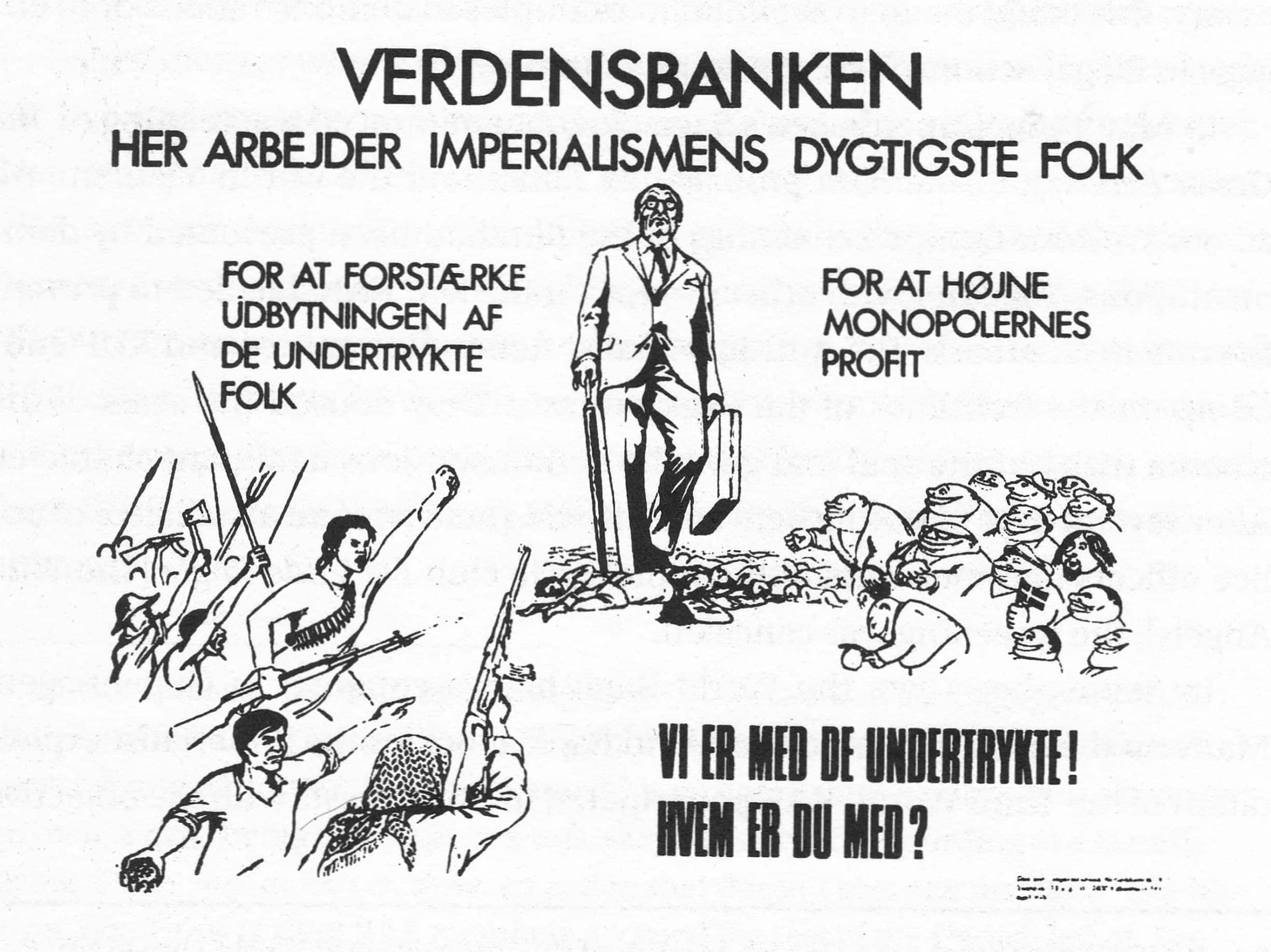
KUF/Anti-imperialistic Action Committee poster in protest against the World Bank congress in Copenhagen 1970: “The World Bank: This is where imperialism’s most effective minions work in order to reinforce the exploitation of the oppressed and to increase the profits of the monopolists. We are on the side of the oppressed! Whose side are you on?”
Tøj til Afrika
With regard to the material support for liberation movements, KUF founded the organization Tøj til Afrika, TTA, in 1972. TTA mainly collected used clothes and sent them to refugee camps in Africa administered by liberation movements where they were distributed according to need. Many KUF and KAK members, as well as sympathizers, became involved in practical work through TTA: clothes needed to be collected, sorted, packaged, and shipped. Soon, the Copenhagen TTA activists were joined by local chapters in Odense, Løgstør, and Holbæk.
During the project’s first seven years, the following amounts of clothes were sent:
| 1972 | 0.9 tons (to the MPLA in Angola) |
| 1973 | 9.7 tons (to FRELIMO in Mozambique and to the PFLOAG in Oman) |
| 1974 | 4.7 tons (to FRELIMO) |
| 1975 | 13.3 tons (to the MPLA, to the PFLO in Oman and to ZANU in Zimbabwe) |
| 1976 | 9.1 tons (to ZANU) |
| 1977 | 27.3 tons (to ZANU) |
| 1978 | ca. 70 tons (to ZANU) [27] |
TTA also held flea markets in order to raise funds. The most successful flea markets brought about one hundred thousand crowns. Some of the money was used to ship the clothes, and the rest was donated to selected liberation movements.
The illegal work
Both KAK’s leadership and the rank and file were constantly looking for different ways to increase the organization’s support for liberation movements. One of the possibilities was to acquire funds in illegal ways. None of us belonged to the KAK leadership when it was decided to pursue this path. Therefore, we can only take a qualified guess as to why this happened. The guess is based on discussions we have had throughout the years and on what Jan Weimann was told after he had joined the KAK leadership in 1975. There are strong indications for the illegal practice starting as an experiment. The KAK leadership wanted answers to the following questions:
- Was it possible to acquire significant economic means by illegal activities?
- Did the organization have members that could engage in such activities?
- Could the members engaged in these activities hide them from other KAK members as well as from people outside of the organization?
- Was it possible to engage in such activities without using excessive violence?
- Was it possible to engage in such activities without drawing the attention of the authorities?
- Could the activities be defended politically and morally?
- Would the members engaged in these activities answer these questions in the same way as the leadership?
It is important to remember that we did not go directly from collecting clothes to robbing cash-in-transit trucks. Members had partaken in violent demonstrations and direct actions before, such as the petrol bomb attack against the Bella Center. This made the step to robbery easier.
It did not take long before KAK’s leadership considered the experiment successful. This, however, demanded some structural changes within the organization. In particular, security was tightened. As a result, socializing was not a big priority within KAK from 1972 to 1976. Contacts between members focused on the political work. One member close to the leadership was excluded because he was considered a security risk.
PØK claims that KAK’s leadership already agreed to materially support the PFLP by illegal means when Gotfred Appel and Ulla Hauton met with PFLP representatives in Jordan in 1970. We do not believe that. When Gotfred and Ulla traveled to Jordan in 1970, the intention was to discuss politics. The discussions convinced them that the PFLP fulfilled KAK’s criteria for support. PØK has no documentation for criminal activities being discussed, and the slow and experimental way in which KAK’s criminal activities developed suggest that no such discussions took place.
Once the illegal practice was established, it had to be justified politically. The rationale was that as long as significant material support for Third World movements could be acquired without using excessive violence the means were legitimate. We will return to the political and moral aspects of the illegal practice in the section “Means and Ends.”
This was, in short, the history behind KAK’s criminal activities. The degree of violence we were ready to use was discussed before every action. This was a matter of great concern to us. We always tried to minimize the risk for the victims. For example, we put a lot of effort into making batons that would do as little harm as possible. At the same time, yes, we were willing to use batons, warning shots, and physical coercion. We justified this with the significant support that these means allowed us to provide for liberation movements. Regardless of what the exact original intentions of Gotfred and Ulla might have been, the main motivation for us to engage in these activities was always to support liberation movements as effectively as possible.
Our Relationship to the RAF, the PFLP, and Wadi Haddad
Let us be clear:
- We had no connections to illegal organizations in Western Europe, including the RAF in West Germany and the Red Brigades in Italy.
- We collaborated with the PFLP, not with Wadi Haddad.
- We were a self-governing and independent organization, not a PFLP cell.
We reject PØK’s suggestion that KAK, and later M – KA, belonged to an international “terror network.” PØK’s claims are false; they are based on a small portion of facts and a big portion of imagination. He favors drama over documentation.
PØK suggests that we collaborated with the RAF. That is nonsense. Already in 1975, we published a critique of the RAF’s theoretical and practical approach in Kommunistisk Orientering. [28] We never shared the RAF’s analysis that West Germany was a fascist state with a democratic facade. Furthermore, the RAF wanted to support the struggle in the Third World by building an anti-imperialist front in Western Europe. We considered this utterly
impossible. We never sent out a single communiqué to explain our actions precisely because of this. For us, there was no feasible revolutionary perspective in Western Europe. The change had to come from the Third World, and therefore the most important thing to do for Western anti-imperialists was to support Third World liberation movements materially. We have stated this over and over again in our articles, pamphlets, and books. [29]
The primary reason for us not having any contact to the RAF was therefore political. However, there was also a tactical reason. When we began collaborating with the PFLP, we also saw many other Europeans visiting them. We were not interested in meeting or even being recognized by them. In light of our illegal activities, any form of contact with the RAF or similar groups would have been a major security risk. Therefore we developed procedures with the PFLP that ensured us not having contact with other Europeans during our visits. We did not want an arrested RAF member mentioning a secret Danish group involved in robberies as a means to support Third World liberation movements. For the same reason, we avoided contact with Palestinian activists in Denmark. Only once, after we had lost contact with the PFLP during the breakup of KAK and the subsequent founding of M – KA, did we decide to get in touch with PFLP members living in Denmark. We instantly paid a price for this: the PFLP members were under surveillance by PET agents, who consequently also took an interest in us. We never repeated that mistake.
That the RAF and KAK/M – KA were very different organizations is also confirmed by the way they related to Palestinian organizations. We got in touch with the PFLP because we wanted to support them. The RAF got in touch with Fatah because they wanted them to provide military training and equipment. [30]
After the civil war in Jordan in 1970, a rift occurred between the PFLP and Wadi Haddad’s Special Operations Group. The RAF was interested in collaborating with Wadi Haddad. We were not. Instead, we consciously distanced ourselves from him.
It is true that a number of meetings were held between the KAK leadership and Haddad. The purpose of these meetings was to gather information. What did his group stand for? Was its cause worth supporting? Did it seem feasible to collaborate with him? And, if so, did it seem possible to collaborate with him without putting our own activities at risk? Our security was important to us, because it was the basis on which we were able to do what we did.
We decided for various reasons not to collaborate with Haddad. The decision was unanimous among the KAK leadership. The reasons were the following:
- The most important one was that Haddad’s actions had little to do with mobilizing the Palestinian people. Instead of creating popular resistance against the Israeli occupation, as for example the Intifada did, Haddad chose elitist actions, that is, actions that required a high level of training and sophisticated equipment. The effect was that the actions pacified rather than mobilized the Palestinian population because ordinary Palestinians could not partake in them. It was militant demonstrations and throwing rocks at Israeli soldiers that inspired widespread resistance.
- We were puzzled by the fact that Haddad had opened the first of our meetings by asking what we could do for him and by explaining what he could do for us. Practical collaboration seemed more important to him than common political ground. This went against our principles. We always discussed politics first.
- Haddad’s operations simply became increasingly unsuccessful. When he had organized hijackings and similar high-profile actions as a PFLP member, his intention was to put the Palestinian question on the map. With this, he succeeded. After his split from the PFLP, however, all of his actions were fiascoes, both practically and politically.
- We thought that the PFLP had the right political analysis of the situation in Jordan after the so-called Black September of 1970: In the late 1960s, the Palestinian organizations in Jordan decided to be very open. They carried weapons in refugee camps and also on the streets of Amman. Jordan was also used as a base for operations against the Israeli occupation in the West Bank. Palestinians comprised 60 percent of Jordan’s population and King Hussein began to perceive them as a threat to his rule. In September 1970, he ordered a military attack on the refugee camps. The result was that the Palestinian organizations were forced to leave the country and move to Lebanon. George Habash and Wadi Haddad had different answers to this. Haddad concluded that the resistance movement had to go underground since it was not strong enough for an open, and therefore vulnerable, presence in an Arab country. Habash concluded that the resistance movement had to stay above-ground and be visible, since this made popular support more likely. Besides, one needed to defend the refugee camps in Lebanon, especially in light of the right-wing Christian forces active in the country.
The reason why we decided to continue our collaboration with the PFLP under the leadership of George Habash was that it had the popular base that we always saw as a precondition for supporting any movement. Once M – KA was founded, the contact with Wadi Haddad and his group ceased completely. Haddad died shortly after.
The RAF’s connections to Haddad are well documented. Haddad was behind the Landshut hijacking on October 13, 1977. The plane ended up in Mogadishu, Somalia, where the hijackers demanded the release of imprisoned Palestinians and RAF members in exchange for the release of the Landshut hostages. The operation ended in a defeat for Haddad when a German antiterror corps stormed the plane and freed the crew and passengers.
In the end, all that is true is that we knew someone who was collaborating with the RAF. However, that’s it, and it’s a curious decision on PØK’s part to use eighty pages in his book to tell the story of the RAF. Don’t get us wrong: it is an interesting story and we understand that it increases the book’s suspense value – it just has nothing to do with the Blekingegade Group.
PØK also claims that the KAK members traveling to meet with PFLP representatives did not get their passports stamped at airports in the Middle East. That is completely false. This only happened on the few occasions we met with Wadi Haddad in Baghdad. If PØK had bothered to look more carefully into the court documents, he would know that we used different passports. We needed them precisely because our passports did get stamped when we traveled to the Middle East. We usually claimed stamped passports lost so we got new ones. In fact, PØK could have simply contacted the Danish passport authorities to receive all the relevant information. But it certainly makes for a better story if he tells about young Danes secretly smuggled across Arab borders.
We Were a Self-Governing and Independent Organization
It is completely false to suggest that we were a “PFLP cell.” This was never the way in which we related to the PFLP. In the context of a hierarchical organization, a “cell” receives orders from above. We always had full control over our activities. Our practice was determined by our own political analysis and our own strategic decisions. We have never had a meeting with the PFLP without discussing politics.
We did not primarily support the PFLP because it wished to establish a Palestinian nation state, but because the PFLP envisioned a socialist society in the Arab world and because it had an explicitly internationalist outlook. The PFLP trained many members of liberation movements in the Third World. The first FSLN guerrilla fighters, the so-called Nicaraguan Sandinistas, were trained in a PFLP camp in Lebanon. The Sandinistas went on to fight a successful liberation struggle and seized power in Nicaragua in 1979. Supporting the PFLP therefore had an important internationalist dimension for us, because it also meant supporting many other Third World liberation movements.
We were an independent group with our own political outlook. At times, this outlook differed from that of the PFLP. For example, we were skeptical of the PFLP developing close ties to the Soviet Union in the 1980s, and we criticized their commandos crossing the border from Lebanon for actions inside Israel, since the character of these actions was as elitist as Haddad’s and often caused bloody reprisals by the Israeli state.
Historical Parallels: The Wollweber League
The Blekingegade Group as an organization involved in illegal and secret political work has been called unique in Danish history. But that is not true. There were others. If we want to find them, we have to go back to the time between the two world wars, when the so-called Wollweber League was active in the country. [31] The Wollweber League consisted of people who, after Hitler’s rise to power in 1933, were convinced that everything had to be done to stop the Axis powers (Germany, Italy, and Japan), even if this included illegal actions on the territory of Denmark or other countries not ruled by fascist governments. [32] Denmark was a parliamentary democracy at the time, with the DKP being represented in parliament. Yet, this did not deter the Wollweber League members from bombing ships in Danish ports or smuggling weapons to Spain.
The perspective of the Wollweber League was international. Even if there was democracy in Denmark, international politics were not democratic. The dark clouds of fascism and Nazism threatened everyone. The Wollweber League members saw it as probable that the Axis powers would bring the world yet another gruesome war. The dilemma they were facing was similar to ours: Was it justifiable to use illegal means to damage Danish property and to even endanger innocent people when you had the option to work legally within the democratic framework? As shown by their actions, their answer was yes. Here are three examples:
- On September 3, 1935, Kaj Gejl used a petrol bomb to damage the American ship United States in the port of Copenhagen. After three failed attempts, he succeeded with the fourth. The United States was going to be sold to Italy. Mussolini wanted it for the transport of troops to Abyssinia, where Italy was engaged in a brutal war of conquest.
- On May 22, 1938, Alberti Hansen and Kaj Thandrup Christensen blew up two Spanish trawlers in the Frederikshavn shipyard. The trawlers had been ordered by the Spanish government before the civil war, but, given the course of the war, it had to be assumed that they would end up in the hands of Franco. Franco would have most likely equipped them with cannons and used them to attack the naval shipments of weapons to the Republican troops. He had already done so with a trawler that had fallen into his hands earlier.
- This concerns not a single event but a solidarity campaign: during most of the Spanish civil war, Richard Jensen chartered ships – the so-called krudtbåde, or “powder boats” – to transport weapons and ammunition to the Republican forces. These ships were manned by Danish seamen who volunteered to take the (significant) risk to sail to Spain. Almost one thousand Danish mariners served on these boats.
Just like the Blekingegade Group, the Wollweber League had no desire to make it known that it stood behind these actions. In order for their fight against the fascists to continue, they had to remain invisible.
Another parallel between the Wollweber League and us was the massive disapproval both groups met. Parts of the left called us “Maoists,” “lunatics,” “terrorists,” “anti-Semites,” and so forth. When the Wollweber League blew up the Spanish trawlers in Frederikshavn, the left reacted no differently. In an article published after the event in the DKP’s journal Arbejderbladet [Workers’ Journal], the party’s central committee had the following advice for its readers: “Watch out for provocateurs consisting of Trotskyists, informers, Gestapo agents, and Nazis! … Beware of these elements and their king-pins, who we will soon expose.” [33]
However, there was also an important difference between the Wollweber League and us. The Wollweber League had close ties to the Comintern and was controlled by the Communist Party of the Soviet Union. We have always been completely independent. It is true that some of our actions were recommended to us by others – but it was always us who decided whether we wanted to do them or not. We were in charge, also on the occasions we “borrowed” people from other organizations: they always acted under the leadership of the Blekingegade Group.
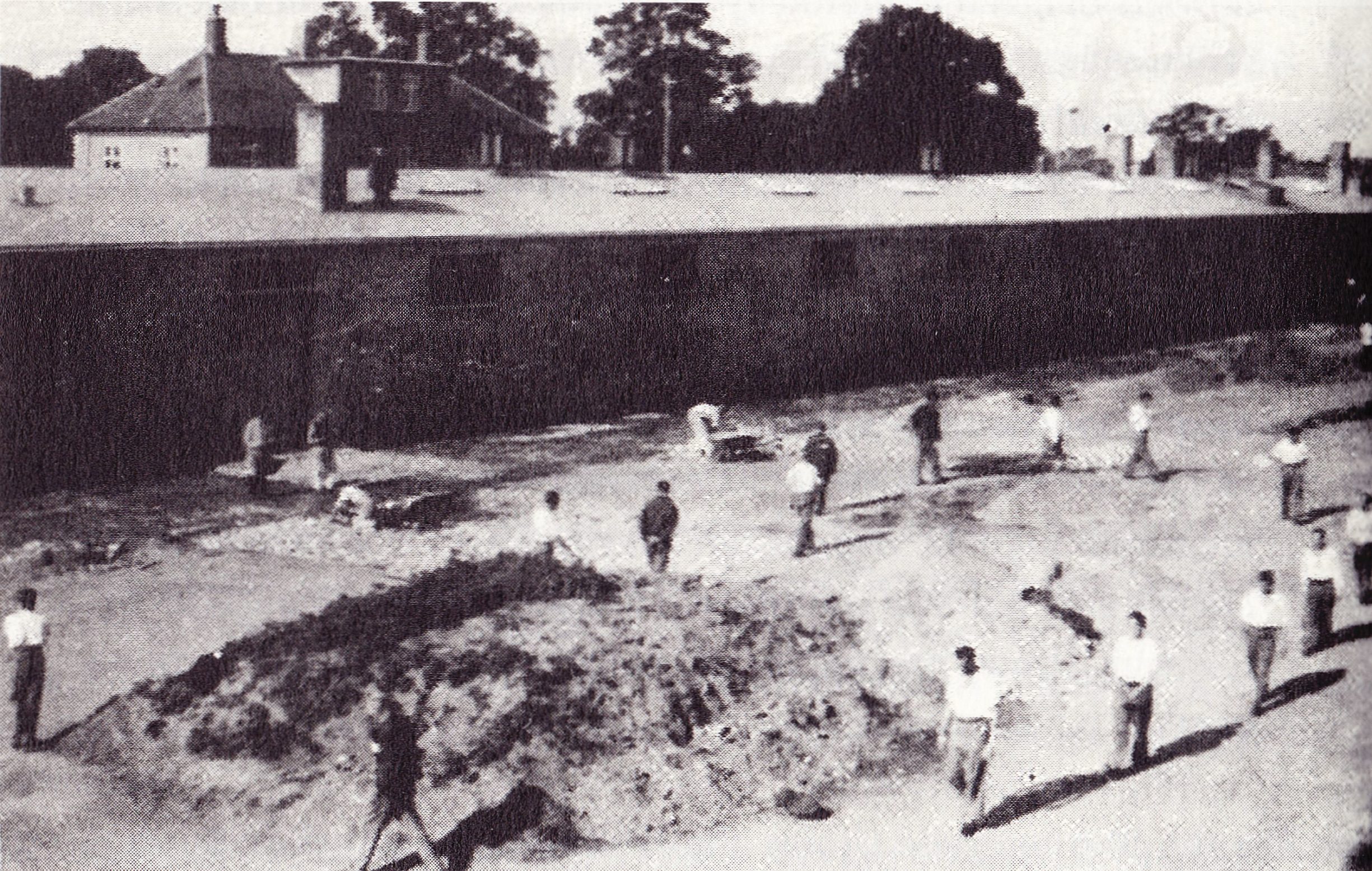
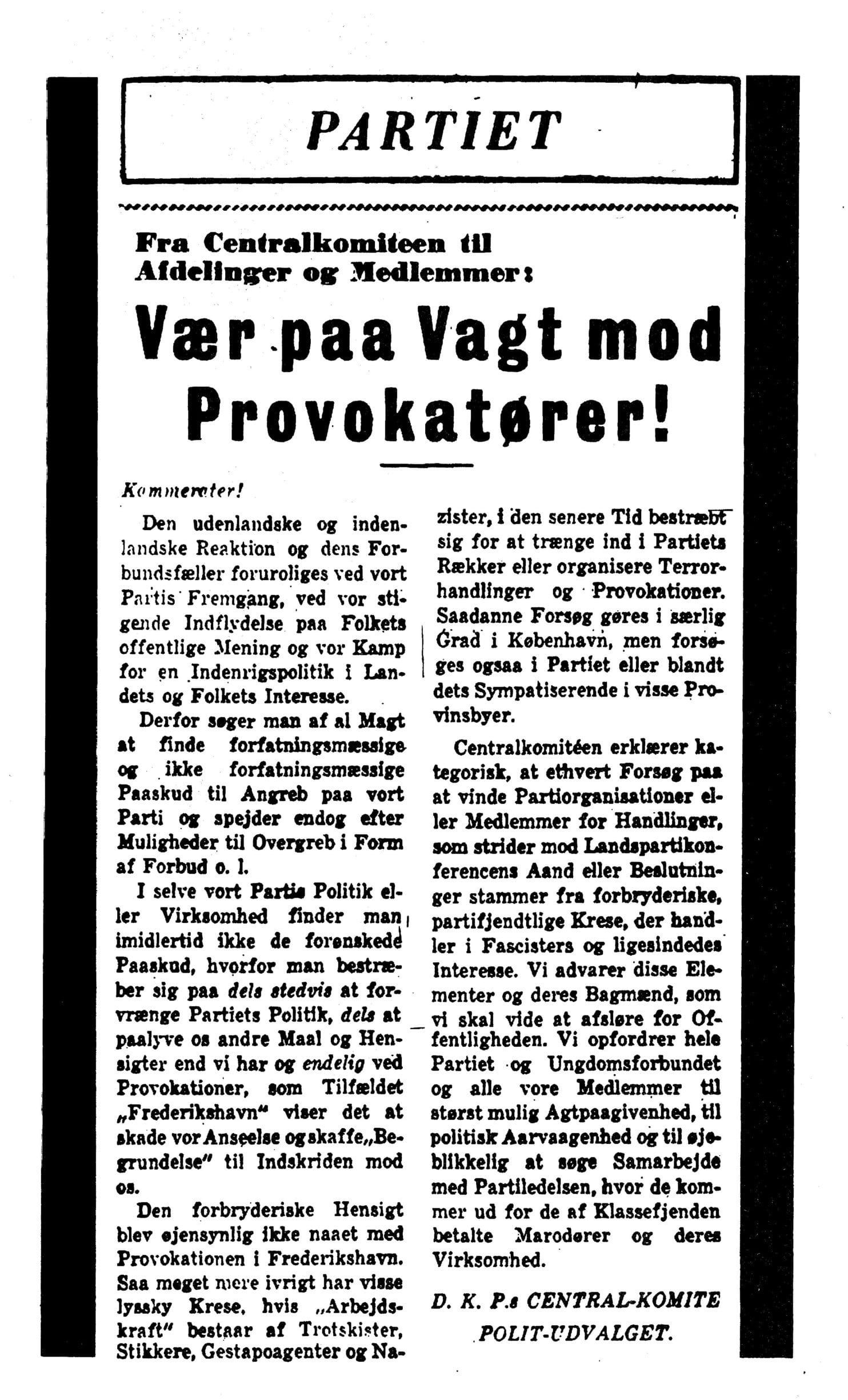
Manifest – Kommunistisk Arbejdsgruppe
In describing the successor to KAK, that is, Manifest – Kommunistisk Arbejdsgruppe, M – KA, we want to focus on three aspects:
- the end of authoritarian leadership;
- the theory of unequal exchange, which was more nuanced than KAK’s analysis;
- M – KA’s continuation of both legal and illegal support for Third World liberation movements.
The KAK Split
In 1977, personal animosities and power struggles within KAK escalated. Initially, Gotfred Appel and Ulla Hauton were KAK’s undisputed leaders, surrounded by enthusiastic but unschooled militants in their early twenties. By the end of the 1970s, however, many members had a decade of political experience behind them, they had traveled, organized solidarity projects, and so on. They had matured and developed their own perspectives. Some of them were bothered by KAK’s internal discipline that didn’t allow for theoretical
improvements. Neither the transformation of imperialism nor events like the oil crisis led to adjustments of KAK’s political foundations. Ideas for projects were never put into practice, because members were not used to doing things without receiving orders. Furthermore, there were personal conflicts. Ulla felt disrespected by male members. Gender discrimination was without doubt a problem within KAK, and this was the time when the Redstockings movement was strong, also in Denmark. [34] Eventually, it all came to a head when female members, with the approval of the leadership, demanded that male comrades undergo “criticism and self-criticism” sessions. Men who refused to participate were threatened with expulsion. This was serious, as membership in KAK was central to KAK members’ lives. Politically, there was nowhere else to go either. Not many organizations on the left prioritized practical support for liberation movements. KAK members were proud of their organization.
The criticism and self-criticism sessions lasted through the winter of 1977-1978 and effectively put a halt to all other activities. Female members demanded the expulsion of several men. Friendships and relationships were put to the test. Eventually, it became obvious to several members, both men and women, that things had gotten out of hand. Upon their initiative, a few meetings for the rank and file were organized. The leadership was not invited. The first of these meetings took place on May 4, 1978. About thirty members gathered in a house, where a few of them lived communally. The meeting’s agenda was to end the anti–gender discrimination campaign and to analyze how things could have gone so wrong. What were the problems within our organization that had allowed this to happen? A few days later, Ulla and Gotfred were called to a meeting in order to present their views. Ulla was furious and insisted on the campaign continuing. In the end, Gotfred came to the meeting alone and suggested suspending all KAK activities for half a year; then, the leadership would present a proper analysis of the events. The majority of the members rejected this proposal; they wanted to analyze the reasons for the anti–gender discrimination campaign and the course it had taken them. In the end, the members expelled Gotfred and Ulla from KAK after a vote.
During the following summer, KAK’s political orientation, practice, and structure were discussed at numerous membership meetings. It became obvious that there was disagreement about how to deal with the mistakes that had been made and how to move on. Long papers with evaluations, future plans, theoretical reflections, and practical suggestions were written and discussed. It looked as if the debates would go on forever. The three authors of this article and some others grew increasingly frustrated with the practical part of our work lying idle. We felt that we had a responsibility both toward the Tøj til Afrika activists and to the liberation movements we collaborated with. They were all wondering what was happening. Our group was willing to continue the political evaluation of KAK’s history and the development of future perspectives, but we also wanted to get back to practical work. In August 1978, we presented our thoughts for everyone and announced the founding of a new organization. This effectively split the former KAK into three groups:
- Gotfred Appel and Ulla Hauton, who had refused to accept their expulsion, continued to work under the name KAK. In Kommunistisk Orientering they declared that they had expelled the rest of the membership. They returned to being loyal to Beijing and followed the line of the CPC without reservation. The liberation movements they now supported were the ones that China supported. Chinese foreign policy at the time was built on a division of the world in three parts, whereby the two competing imperialist powers – the USA and the Soviet Union – controlled the rest. China saw the Soviet Union as the more aggressive power of the two, against which the rest of the world had to be defended. This meant that Third World nations and Western countries had a common interest in fighting the Soviet Union. KAK uncritically adopted this “Three Worlds Theory.” Among others, they supported Pol Pot in Cambodia.
- Some former KAK members founded the Marxistisk Arbejdsgruppe, MAG. They intended to continue with the analysis of KAK’s past mistakes, while trying to develop a new form of organization and solidarity work. MAG was only short-lived. It folded in 1980.
- The three of us and a handful of other former KAK members prepared a new organization. Everything that was related to the illegal practice was moved to a safe location. We reestablished contact with the liberation movements we had collaborated with and explained the new situation. We rented office space and established a print shop. The majority of the Tøj til Afrika activists in Copenhagen and the TTA chapter in Odense decided to work with us. Later, another TTA chapter was established in Århus.
The Foundation of Manifest–Kommunistisk Arbejdsgruppe (M-KA)
On September 3, 1978, Manifest – Kommunistisk Arbejdsgruppe was officially founded. In the beginning it consisted of only seven members, including Holger Jensen and the three of us. In October, the first issue of our journal Manifest appeared. The first article, “Kommunistisk Arbejdsgruppe dannet” [Communist Working Group Founded] outlined our perspectives and intentions. [35] In certain ways, we felt like we were KAK’s heirs, but we also wanted to develop our own analysis and improve our practice.
M – KA’s organizational goal was different from KAK’s. Even if Gotfred Appel considered revolutionary development in Denmark to be highly improbable, he intended to build an organization that had the resources, the knowledge, and the discipline to act once a revolutionary situation in the country would occur. In the end, his support for Third World liberation movements had a clear Danish perspective: [36] KAK was to be ready for the day the revolution returned to Western Europe.
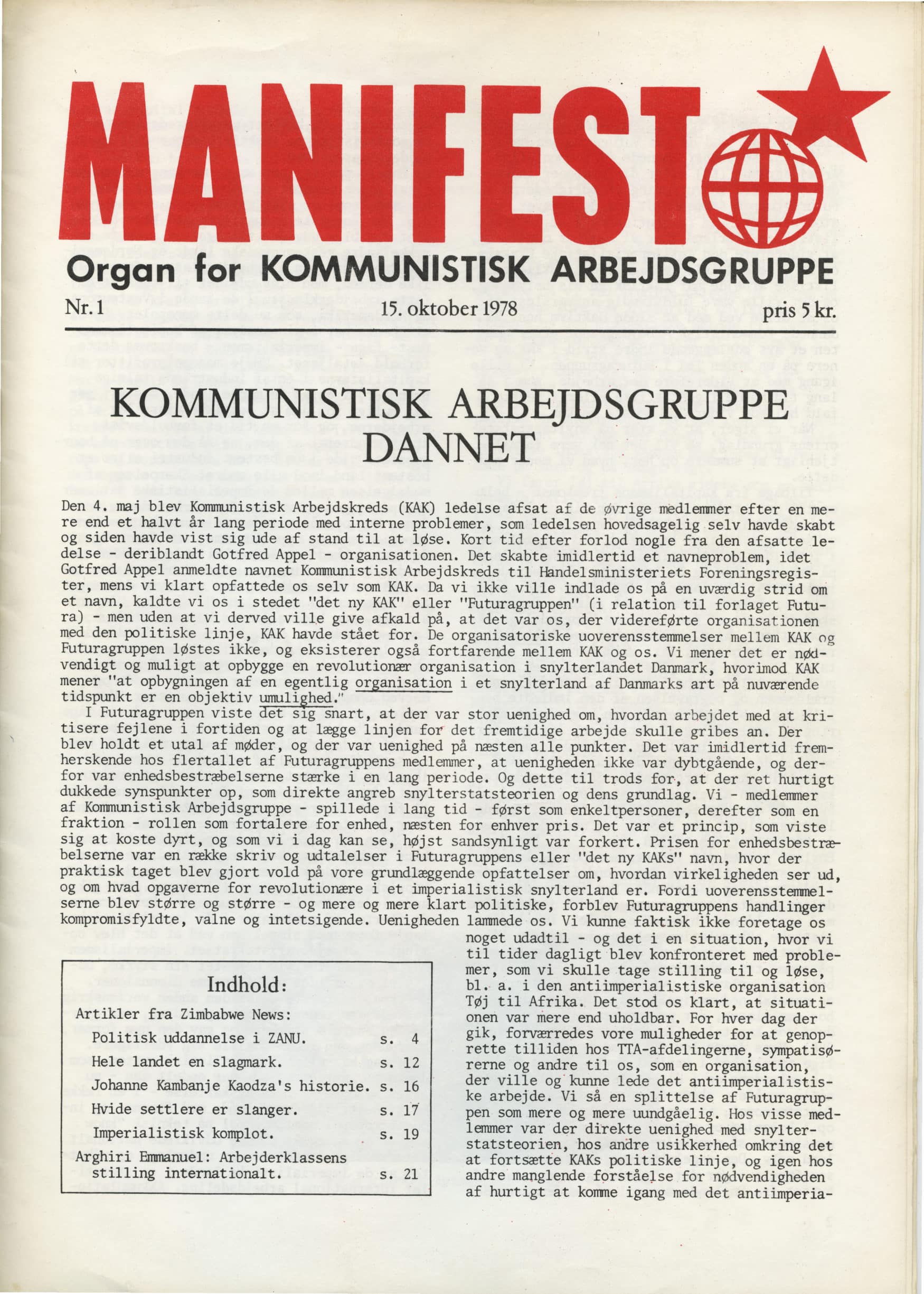
For M – KA, supporting liberation movements was a revolutionary end in itself. Any possible revolution in Denmark was too far away and too abstract to even consider. Rather, we saw three things as being crucial: to develop political analysis and theory; to spread our analysis and theory; and to continue with the illegal and legal practice. We wanted to provide material support for liberation movements as an organization with a solid independent analysis. The Danish perspective moved further and further into the background and gave way to a thoroughly global perspective. One could say that M – KA was a reflection of “globalization” before the term was invented. Our logo combined a globe with a five-pointed star.
Establishing a new organization set an enormous amount of energy free. We had been in the doldrums for almost a year. The authority of Gotfred Appel and KAK’s internal discipline had been hindering independent initiatives and developments even longer. Now there were new possibilities. It was time to act again.
M – KA’s Structure
M – KA was a small, but hard-working group. People were either “full-time activists” on unemployment or they dedicated all of their free time to the organization. Some people left, others joined. The membership was always around twelve to fifteen people. Because of the illegal work, new members were only fully included after a year, once we had gotten to know them well. There was a bigger circle of sympathizers and volunteers who helped with the legal solidarity work. Our journal Manifest had about two hundred paying subscribers.
The way M – KA was organized marked a rupture with the centralism and closedness of KAK. We had a democratically elected leadership and, all in all, a horizontal structure. We wanted to form an organization able to develop its politics by way of internal as well as external discussion. Holger was a driving force in the early days of M – KA, but solely because of his dedication – he had no formal leadership role. His death in 1980 was a hard blow to us. However, the following years proved that M – KA had become strong and grounded enough to continue its work nonetheless. Administrative, theoretical, legal, and illegal tasks were assigned on the basis of mutual agreement. This gave the organization stability and made it effective.
It is clear that the illegal practice set limits as to how open M – KA could be. Only those involved in the illegal practice knew the details. But the decision about which liberation movements to support was taken by the entire organization. We had also established an offset print shop and a publishing house in the northwest of Copenhagen. There we printed journals of liberation movements, information material for Tøj til Afrika, and, eventually, a series of pamphlets and books. [37] The expenses were paid for by member contributions, which depended on the individuals’ means. In some cases, those were quite high.
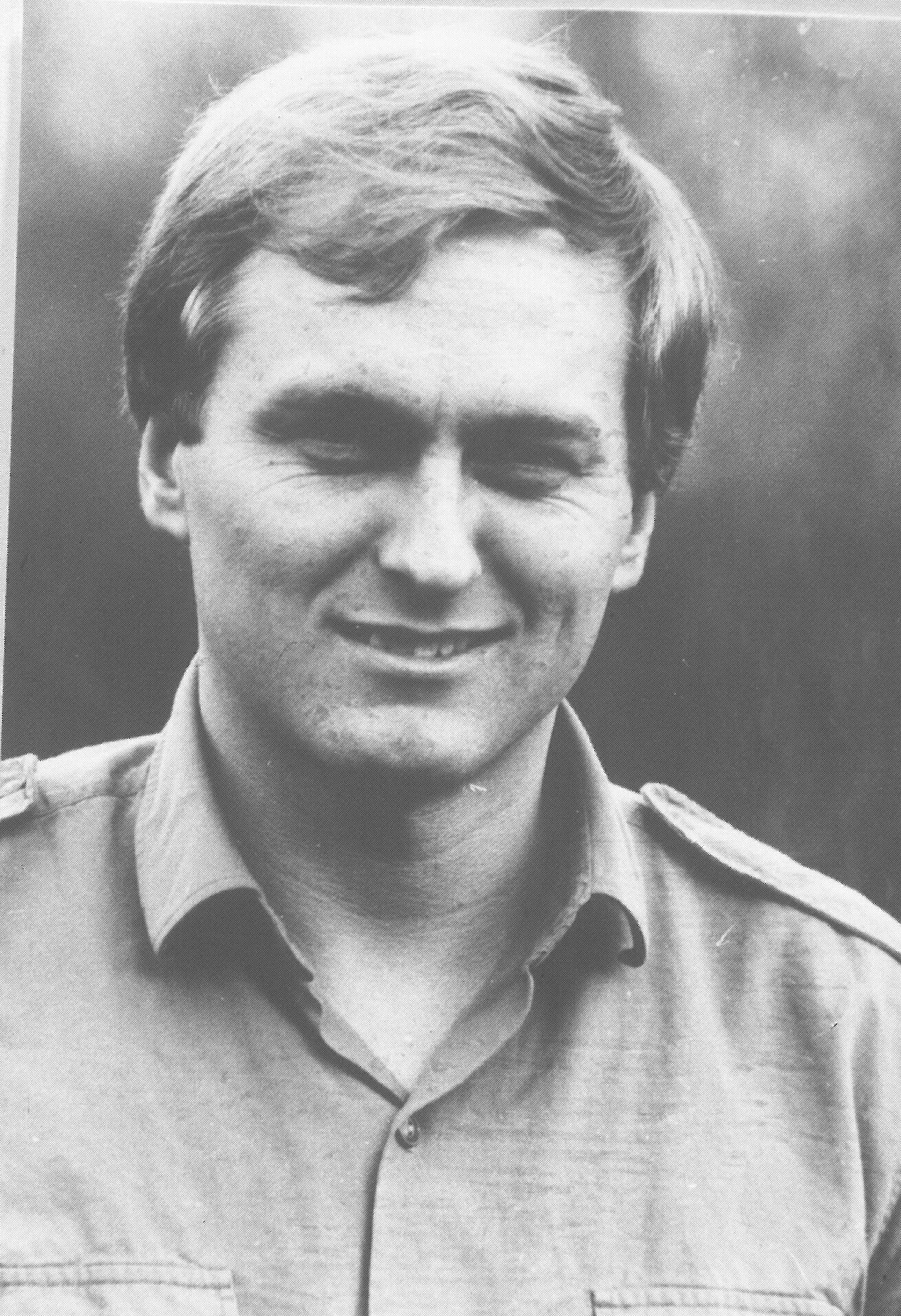
The Development of M – KA’s Politics
To advance political theory was important for M – KA. We arranged study groups together with Tøj til Afrika. We set up a small library at our space in northwest Copenhagen. This was before the Internet age, so we subscribed to the BBC World Service, which had daily news cables coming from the Middle East, Southern Africa, and other regions. This allowed us to keep ourselves updated on the developments in regions in which we supported liberation movements.
We were convinced that in order to develop an effective practice we needed to study economic and political relations and to have a concrete analysis of where and how to get involved in people’s struggles. Our practice was always informed by strategic and tactical reflections that we dedicated much time to. An important factor was the discussions we had with liberation movements and the experiences we shared with them. We developed our political perspectives together.
We also resumed our travels. M – KA members went to Zimbabwe, Mozambique, South Africa, Botswana, the Philippines, and different countries in the Middle East. The entire M – KA membership visited the PFLP in Lebanon in 1981, both to discuss politics and to give members who had never been to Palestinian refugee camps an opportunity to see them.
From Lenin to Unequal Exchange
Gotfred was a Leninist. If there was a theoretical problem, his answer was, “Well, let’s see what Lenin had to say.” All answers could be found in Lenin’s Collected Works – one just had to open the right one of the forty volumes. KAK’s analysis of imperialism was based on Lenin’s 1916 text “Imperialism, the Highest Stage of Capitalism.”
In the mid-1970s, KAK tried to update Lenin’s analysis in the spirit of Varga and Mendelsohn’s book New Data. [38] For years we studied capital export to the Third World and profit rates. We studied the development of transnational corporations and the extraction of raw materials. Eventually, we had to conclude that Lenin’s analysis of imperialism was no longer applicable. Foreign direct investments and profits could no longer explain the rising gap between the rich countries and the poor. However, KAK was not able to draw the necessary conclusions and revise its theory.
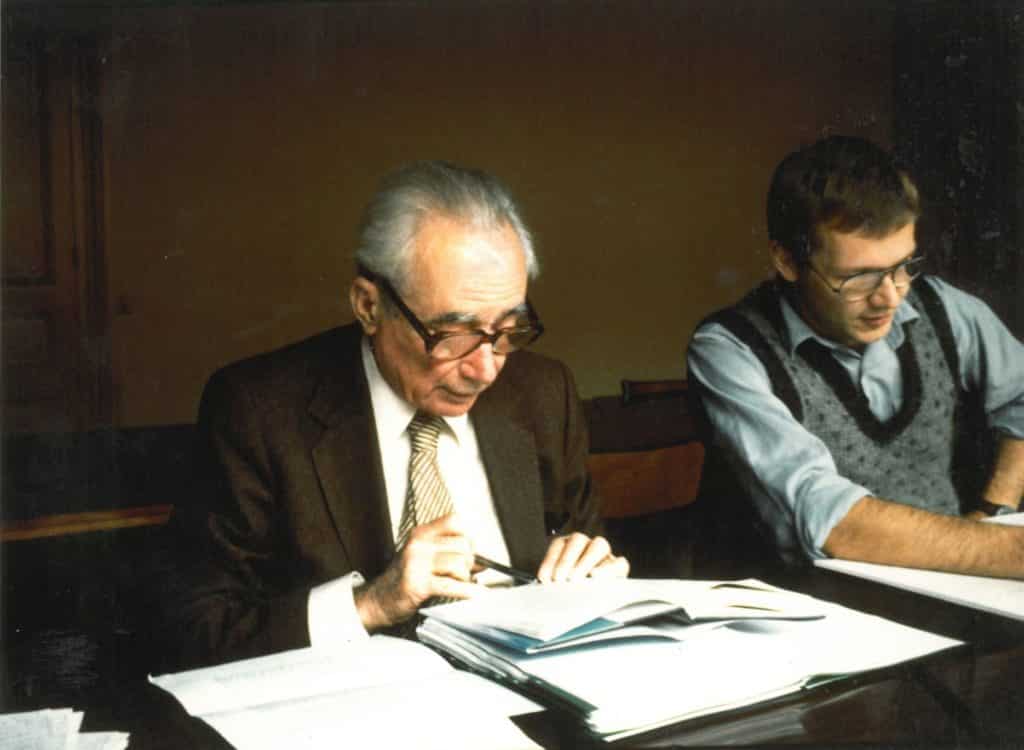
M – KA did not have that problem. We were able to react to the changes that the analysis of imperialism had gone through in the 1970s. The Egyptian economist and historian Samir Amin had spoken of the rich countries forming the “center” and the poor and dependent countries the “periphery” of a global economic system that led to Third World poverty and underdevelopment. The American sociologist Immanuel Wallerstein had described the historical development of the world system and the division of poor and rich countries from the fifteenth century to the present. And Arghiri Emmanuel had presented the theory of “unequal exchange”: rather than capital export and superprofits, unequal trade was the
reason for the world being divided into rich and poor countries. Unequal exchange happens when goods are produced in Third World countries where wages are low and sold in rich countries where wages are high. Unequal exchange can, in short, be described as the result of different pay for the same kind of work. [39] What impressed us particularly with Emmanuel’s approach was how scientific it was. His analysis was a direct continuation of Marx’s Capital. It had the same basis: a thorough examination of theories and analyses of foreign trade from the nineteenth-century classical economists to this day. Each argument was examined carefully.
We first contacted Emmanuel in 1974, but the connection became much closer after KAK’s split. Following the foundation of M – KA, we went to visit him several times. He also kept in touch after our imprisonment, and contact only ceased when he died in 2001. When we worked on our book Imperialismen i dag, he read the manuscript and was kind enough to provide a preface. It included the following paragraphs:
Often in meetings, academic or other, where I was to put the case for my theses on unequal exchange and on the international exploitation which was its outcome, sincere left-wing militants, somewhat at sea, asked the same question in different forms. If this is the case, if the proletariat no longer exists in our industrialized countries, if all, or almost all wage-earners, white collars and blue collars together, have become a labour aristocracy by definition producing less value than their wages allow them to appropriate and thus becoming the objective allies of imperialism, which brings them the supplement, what, then, becomes of the political action of revolutionary marxists? To whom, to which class, to which strata of society can they therefore address themselves? …
This is the question to which the members of the Kommunistisk Arbejdskreds have replied in this book. One must, they say, quite simply, put oneself at the service of the classes which have an interest in overthrowing imperialism, “… no matter where they are geographically.” This is clearer and more distinct than anything I have been able to mumble in answer here and there to my various questioners. …
Now, as a result of some historical changes which Marx could not forecast, classes are no longer distributed “geographically” today, according to the classical intranational model. The proletariat, the true party to the cause of the socialist revolution, has practically disappeared in the affluent countries of the centre. It continues to exist in the periphery. …The structure of this book reflects the progress of their praxis, as I have been able to witness it through personal contacts I have had with them. Firstly to know the world, then to transform it. But … to know the world as it is today and not as it was in Marx’s time and nevertheless to do this by using the marxist method. [40]
In Imperialismen i dag we tried to give a realistic estimation of unequal ex-change. Using trade figures and wage statistics we calculated that in 1977 about 350 billion U.S. dollars were transferred from the Third World to the rich (OECD) countries. [41]
Emmanuel withdrew from the academic world in the late 1980s. He died in 2001 at the age of 90. Since then, different people have continued to study unequal exchange. If one set the exchange balance to zero in 1865, then calculations of trade, wages, and purchasing power show that unequal ex-change led to a transfer of value equivalent to 1,750 billion U.S. dollars from poor to rich countries in 1995, which equaled 6.6 percent of the gross world product. The three biggest losers of unequal exchange in 1995 were China, Mexico, and Indonesia. The three biggest winners were the U.S., Japan, and Germany. Today, unequal exchange leads to a transfer of value equivalent to more than 2,000 billion U.S. dollars per year. This amount is many times higher than foreign aid, private credits, and corporate investments going to Third World countries combined.
Other Studies
Some of the results of the studies we did in M – KA were published in our journal Manifest and in pamphlets and books. [42] We examined the historical origin of the world’s division into rich and poor countries; we looked at why some former colonies – in South America – remained poor, while other former colonies – in North America – developed and became rich; we studied crisis theory and capitalism’s ability to adapt and transform; we studied the Soviet Union’s development in the 1980s; we looked at U.S. military strategy in the Third World after the Vietnam War.
We were constantly searching for new information and discussed our perspectives both with political allies and academics. In the mid-1980s, we were involved in starting a political journal, Liberation, which was distributed in Tanzania and Uganda. In short, we find it difficult to accept PØK’s portrayal of M – KA as a rigid and dogmatic organization.
Solidarity Work
M – KA proceeded with the legal solidarity work that KAK had started. Tøj til Afrika continued to send tons of clothes, shoes, and tents to camps hosting refugees from Zimbabwe, Mozambique, Namibia, and Angola. We visited these camps to make sure that all the deliveries arrived. Together with Ulandsklunserne, [43] we arranged monthly flea markets. The earnings went to political refugees from South Africa or to the PFLO in the Arab Gulf. We also spread information about the liberation movements we supported.
In 1983, we published a book about the conflict in the Western Sahara. [44] In 1985, we were involved in starting the Western Sahara Committee (Vestsaharakomité), which supported refugees from the region. We were also involved in the Namibia Alliance (Namibiaforeningen), the Philippines Committee (Filipinerkomité), and the El Salvador solidarity campaign.
In 1987, we opened Café Liberation in the Islands Brygge district, near the center of Copenhagen. The café was exclusively run on voluntary labor. All earnings went to liberation movements.
We had four criteria for deciding which movements to support:
- a socialist perspective
- broad popular support
- strategic significance for the struggle against imperialism
- a tactical consideration: we wanted our limited means to be used in ways that made a difference. This is why we often supported movements during the earliest phase of their struggle, when they did not yet receive much other support.
Let us name one example: In the early 1980s we supported the Black Consciousness Movement, BCM, in South Africa. The BCM largely consisted of students and youths in poor townships around Johannesburg. We printed a journal related to the movement, Isandlwana Revolutionary Effort, as well as flyers and posters. We sent the material to Botswana, from where it was smuggled into South Africa. We also supported a pig farm and a bottle store in Botswana, which were managed by political refugees from South Africa and functioned as a base for actions on South African territory.
This is just one example that proves that our support work was more diverse – in terms of both the form it took and the people it reached – than what PØK makes his readers believe.
The reason for continuing the illegal practice was first and foremost that it allowed us to provide much bigger quantities of material support than our legal activities.
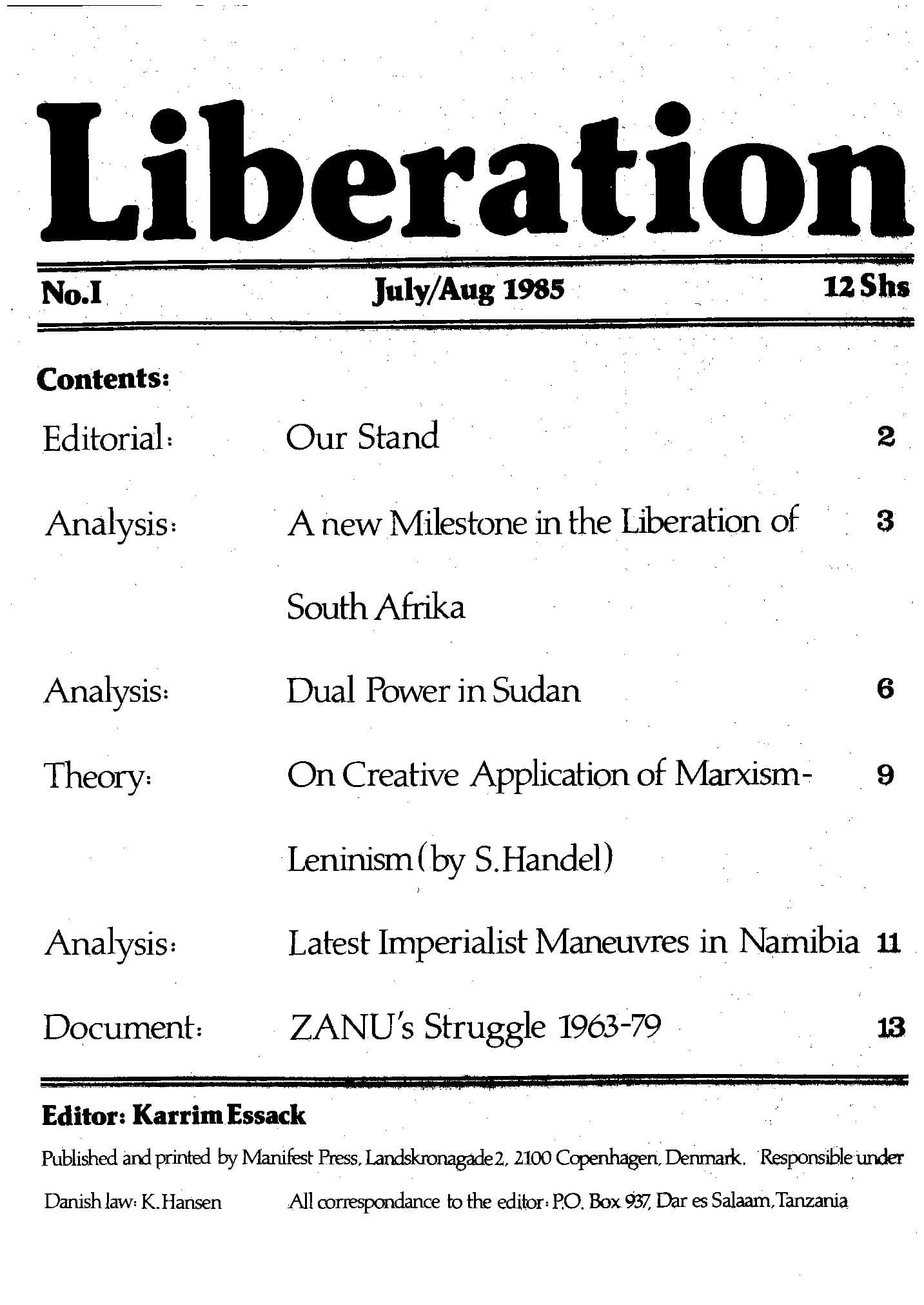
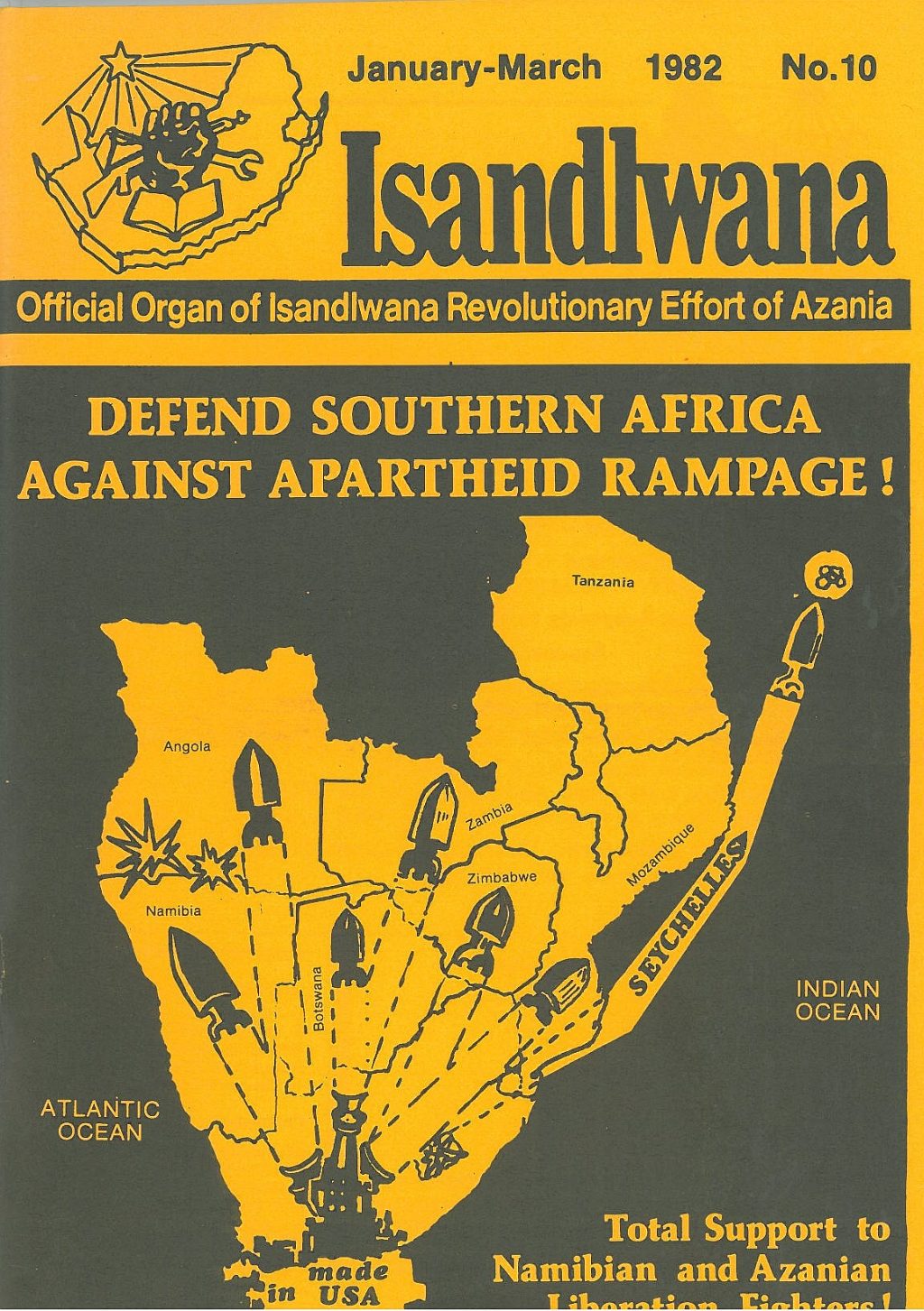
Notes
[3] The group was also known under the names “External Operations” and “Special Operations Group.” – Ed.
[4] In 1968, Benito Scocozza cofounded the Maoist KFML. He served as its chairman until 1975, and as the chairman of its successor, KAP, until 1984. (For KFML/KAP, see the appendix.) – Ed.
[5] KAK, Til alle kommunister! Til alle der vil socialisme [To All Communists! To All Who Want Socialism] (Copenhagen: Futura, 1964). Online in Danish on snylterstaten.dk
[6] KAK, Perspektiverne for socialisme i Danmark [Perspectives for Socialism in Denmark], insert in Kommunistisk Orientering nos. 3–5, 1966. Online in Danish on snylterstaten.dk
[7] See also KAK, To linjer [Two lines], insert in Kommunistisk Orientering no. 18, 1968, to no. 2, 1969. Online in Danish on snylterstaten.dk
[8] See Karl Marx and Friedrich Engels, The Communist Manifesto (1848), Online on MIA – Marxist Internet Archive.
[9] No Kommunistisk Orientering issues were published between 1970 and 1974 – see also the introduction. – Ed.
[10] Don Barnett was the founder of the LSM (see the appendix). – Ed.
[11] Our views on the Soviet Union were summarized in the pamphlet Myter om Sovjet [Myths about the Soviet Union], authored by M.K. Andersen and T. Retbøll (Copenhagen: Manifest, 1986).
[12] Ernesto (Che) Guevara, “Vietnam and the World Struggle for Freedom”, quoted from George Lavan (ed.), Che Guevara Speaks (New York: Pathfinder, 1967), 159.
[13] Jawaharlal Nehru, Glimpses of World History (Delhi: Oxford University Press, 1982 [1934]), 548. Online on historydepartmentphilos.weebly.com
[14] Ernesto (Che) Guevara, “Speech at the Afro-Asian Conference in Algeria”, February 24, 1965. Online på MIA
[15] Julius K. Nyerere, “A Call to European Socialists” (November 1972), quoted from Nyerere, Freedom and Development: A Selection from Writings and Speeches 1968-1973 (Dar es Salaam: Oxford University Press, 1973), 374-75.
[16] Eric Hobsbawm, Labouring Men (London: Weidenfeld and Nicolson, 1964), 341.
[17] Joan Robinson, Freedom and Necessity (London: George Allen & Unwin, 1970), 64-66.
[18] For an analysis of the development of national liberation struggles, see also Torkil Lauesen, “Den nationale befrielseskamps problemer” [The Problems of the National Liberation Struggle], 3 parts, Gaia nos. 61-63, 2008-2009. Online in Danish on internationaltforum.dk part 1, part 2, part 3
Or on snylterstaten.dk in 2 parts. Part 1, Part 2
[19] Burmeister & Wain (B&W) was a big Danish shipyard (closed 1980), FLSmidth is a major international machine manufacturer, and Tuborg is one of Europe’s biggest breweries. – Ed.
[20] Karl Marx and Friedrich Engels, The Communist Manifesto (1848). Online at MIA
[21] Bente Hansen, “Mossad og Blekingegade” [Mossad and Blekingegade], Salt no. 2, April 2007, 28. Salt is a bimonthly journal for “social, political, and cultural issues,” founded in 1992. “Left-wing mush” is an approximate translation of venstredynen, a dyne being a blanket or a soft, shapeless object; according to a Danish saying, Det er som at slå i en dyne, an action that doesn’t give any results is “like hitting a dyne”; this is what KAK members accused the rest of the Danish left of. The common Danish name used for the left is venstrefløjen, literally, “the left wing.” – Ed.
[22] Venstresocialisterne is a small leftist party founded in 1967. Today, they are part of the 1989-founded Enhedslisten – De Rød-Grønne [Red-Green Alliance], together with the DKP and the Trotskyist Socialistisk Arbejderparti [Socialist Workers Party]. KAP also belonged to the Red-Green Alliance before disbanding in 1994. – Ed.
[23] Ulandsklunserne roughly translates as “ragpickers for developing countries”; it was a collective involved in Third World solidarity projects. – Ed.
[24] WUS Denmark was the Danish branch of the international World University Service, originally an organization focusing on human rights and education. The Danish branch was founded in 1966 and focused strongly on supporting social movements and activists in the Third World. In 1991, it left the international organization and changed its name to Ibis. – Ed.
[25] Mellemfolkeligt Samvirke, roughly “Cooperation between Peoples,” founded in 1944, promotes “the political empowerment of the world’s poor.” Today, it is associated with the international ActionAid network. – Ed.
[26] The Bella Center is Scandinavia’s largest exhibition and conference center; it opened in 1965. – Ed.
[27] The organizations supported by TTA from 1979 to 1986 (when the project disbanded) were ZANU, SWAPO in Namibia, and the IRE in South Africa. – Ed.
[28] KAK, “Kritik af RAFs analyse og strategi” [Critique of RAF’s Analysis and Strategy], Kommunistisk Orientering no. 5, 1975. Online in Danish at snylterstaten.dk
[29] See, in particular, M – KA, Imperialismen i dag: Det ulige bytte og mulighederne for socialisme i en delt verden (Copenhagen: Manifest, 1983); English edition: Unequal Exchange and the Prospects of Socialism (Copenhagen: Manifest, 1986). Online at snylterstaten.dk in Danish and English
[30] Fatah is a left-leaning Palestinian political party founded in 1965. It is the strongest faction within the PLO. Its founder and longtime chairman was Yasser Arafat. – Ed.
[31] This history has been documented in Erik Nørgaard’s Krigen før krigen:Wollweber-organisationen og skibssabotagerne, fra den spanske borgerkrig til besættelsen af Danmark [The War Before the War: The Wollweber Organization and the Sabotage of Shipping Traffic: From the Spanish Civil War to the Occupation of
Denmark] (Lynge: Bogan, 1986) and Krig og slutspil: Gestapo og dansk politi mod Kominterns “bombefolk”, fra besættelsen af Danmark til idag [War and Endgame: Gestapo and Danish Police against the “Comintern bombers”: From the Occupation of Denmark to the Present] (ibid.), volumes 3 and 4 of a four-volume history of the Comintern.
[32] The Wollweber League was named after its founder, the German communist Ernst Wollweber, who, as a young sailor in the Imperial German navy, was involved in the Wilhelmshaven Revolt of 1918, which led to the German Revolution and the end of the Kaiserreich. After the Nazis seized power in Germany in 1933, Wollweber fled to Copenhagen, where he set up an “organization against fascism and in support of the Soviet Union,” i.e., the so-called Wollweber League. The Wollweber League was responsible for more than twenty acts of sabotage – mainly in Northern Europe – against ships serving fascist powers. Wollweber was arrested in Sweden in 1940 and deported to the Soviet Union in 1944. After the war, he was a high-ranking member of the East German SED. – Ed.
[33] Quoted from Erik Nørgaard, Krigen før krigen: Wollweber-organisationen og skibssabotagerne, fra den spanske borgerkrig til besættelsen af Danmark.
[34] Rødstrømpebevægelsen is the Danish term for the international feminist-socialist Redstockings movement, founded in New York City in 1969. – Ed.
[35] M – KA, “Kommunistisk Arbejdsgruppe dannet” [Communist Working Group founded], Manifest no. 1, October 1978. Online in Danish on snylterstaten.dk
[36] See, for example, the pamphlet Det kommer en dag – Imperialisme og Arbejderklasse (Copenhagen: Futura, 1971), published in English as There Will Come a Day: Imperialism and the Working Class (ibid.). Online at snylterstaten.dk in Danish and English
[37] See the website snylterstaten.dk for a list of Manifest publications. – Ed.
[38] E. Varga and L. Mendelsohn (eds.), New Data for V.I. Lenin’s ‘Imperialism, the Highest Stage of Capitalism’ (Moscow: Foreign Languages Publishing House, 1939).
[39] See, in particular, Samir Amin, Unequal Development: An Essay on the Social Formations of Peripheral Capitalism (New York/London: Monthly Review Press, 1977) [French original: L’impérialisme et le développement inégal (Paris: Editions de Minuit, 1976)], Immanuel Wallerstein, The Modern World System (New York: Academic Press, 1974), and Arghiri Emmanuel, Unequal Exchange: A Study of the Imperialism of Trade (New York: Monthly Review Press, 1972) [French original: L’échange inégal: Essai sur les antagonismes dans les rapports économiques internationaux (Paris: François Maspero, 1969)].
[40] Arghiri Emmanuel, “Preface”, quoted from the English edition of Imperialismen i dag: M – KA, English Unequal Exchange and the Prospects of Socialism (Copenhagen: Manifest, 1986), 9-15. Online on snylterstaten.dk
[41] The Organisation for Economic Co-operation and Development (OECD) was founded in 1961 by industrialized nations committed to a market economy. In 2012, it consisted of 34 member states. – Ed.
[42] See the website snylterstaten.dk for a list of Manifest publications. – Ed.
[43] Ulandsklunserne roughly translates as “ragpickers for developing countries”; it was a collective involved in Third World solidarity projects. – Ed.
[44] M – KA, Konflikten om Vestsahara: Polisarios kamp for et uafhængigt land [The Western Saharan Conflict: Polisario’s Struggle for an Independent Country] (Copenhagen: Manifest, 1983).
